Physical Address
304 North Cardinal St.
Dorchester Center, MA 02124
Although many aspects of planning and performing secondary facelift surgery are similar to those of the primary procedure, one must identify and treat not only new problems that are the product of age, but those that have resulted from any prior procedure as well. Often it is these secondary irregularities that present the biggest challenge in terms of creativity, planning, preparation, and technique.
Recognizing the problems in the secondary facelift patient and appreciating their underlying anatomical abnormalities is fundamental to planning and performance of any repair. Although not all problems can always be completely corrected, any surgeon able to recognize their anatomic basis can, through the application of logic and careful planning, select techniques that are safe and effective.
Secondary facelift irregularities are worth every surgeon’s consideration, even if they perform only the occasional secondary procedure, as they exist as compelling reminders of mistakes to avoid in the planning and performance of any primary procedure.
Hairline displacement and disruption remain predictable outcomes of many currently used facelift plans and are a source of disappointment and frustration for patients and surgeons alike. These problems are the result of poor analysis and planning, and failure to use an incision along the hairline when indicated.
Using the SMAS to lift sagging facial tissues and restore facial contour circumvents the problems associated with skin-only facelifts, as it is an inelastic structural layer capable of providing meaningful and sustained support. Although skin must be excised in SMAS procedures, only redundant skin is sacrificed and closure can be made under normal skin tension.
It is not enough in most secondary facelift procedures to limit treatment of the neck to pre-platysmal lipectomy and post-auricular skin excision. For many patients, subplatysmal fat accumulation, submandibular salivary gland hypertrophy and digastric muscle malposition will contribute significantly to poor neck contour and necessitate additional treatment.
The secondary facelift will generally require a comparatively small resection of skin, an increased focus on correcting deep-layer problems and secondary irregularities, and almost universally requires replenishing lost facial volume. In most cases, less focus and effort need be placed on the facelift procedure itself, and increased focus and effort should be placed on restoring lost facial volume, the typically undertreated neck and forehead, and the incompletely rejuvenated perioral area,
Many patients requesting secondary facelifts are chronologically elderly, but can be deceptively young in appearance. A careful medical history must be taken because they often have medical problems consistent for their chronological age group.
The opportunity to perform a facelift is a unique artistic privilege granted to us by our patients that carries a sig nificant responsibility. It deserves nothing less than our best effort, and a few extra hours of our time in the operating room benefits our patients for the rest of their lives.
Performing a secondary facelift is frequently technically demanding undertaking when compared to primary procedures and its difficulty should not be underestimated. The procedure must be carefully planned, meticulously carried out, and the patient’s safety and well-being unfailingly insured.
Performance of the procedure itself only fulfills part of our obligation to the patient and the care they receive perioperatively is arguably as important as the surgery itself. Diligent perioperative care will ensure the best result and reduce the likelihood that problems and complications will occur.
Access video lecture content for this chapter online at Elsevier eBooks+ ![]()
The increased number of patients seeking facelifts at a younger age, coupled with the continued good health of an older group of patients who have already undergone one or more procedures, has resulted in a significant increase in requests for secondary and tertiary procedures. Although many aspects of planning and performing secondary surgery are similar to those of the primary procedure, additional considerations must be taken into account in the evaluation and treatment of the patient presenting for secondary facelift, as one must identify and treat not only new problems that are the product of age, but those that have resulted from any prior procedures as well. Often, it is these secondary irregularities that present the biggest challenge to the surgeon in terms of creativity, planning, preparation, and technique.
Consideration must also be given to possible underlying anatomical compromise that may have resulted from previous procedures but is not evident as a visible problem. This includes possible damage to skin, fat, SMAS and deeper layer structures. Injury to these tissues at the time of the primary procedure can preclude certain maneuvers and limit the overall amount of improvement possible at the time secondary surgery is performed. “Red flag” procedures in this regard include radiofrequency and ultrasonic “skin tightening” treatments, prior “suture lifts”, and prolonged large-volume use of facial fillers (“filler fibrosis”).
As in primary procedures, recognizing the problems in the secondary facelift patient and appreciating their underlying anatomical abnormalities is fundamental to planning and performance of any repair. Although not all problems can always be completely corrected, any surgeon able to recognize their anatomic basis can, through the application of logic and careful planning, select techniques that are safe and likely to produce a significant improvement ( ![]() ).
).
The strategy for treating the secondary and tertiary facelift patient will necessarily differ from that of patients undergoing primary procedures and the secondary or tertiary facelift procedure will generally require a comparatively smaller resection of skin, an increased focus on correcting deep-layer problems, and restoration of lost facial volume – depending upon the skill of the surgeon performing the primary procedure, the technique used, and whether the face was treated comprehensively or not. This is due to the fact that the focus of most primary procedures is usually predominantly on skin resection as this is more easily and quickly performed than more complicated and time-consuming, but superior, SMAS and deep-layer neck maneuvers. In addition, skin resection and skin tightening are the underlying cause of many secondary problems and thus very often the skin elevated and recruited by SMAS treatment at the secondary or tertiary procedure is needed to correct these problems and will not be excised, or only minimally so.
It is also the case that the surgeon at the primary procedure often had a narrow focus mostly limited to the face (cheeks and jowls). Often they exhausted themselves performing the “facelift”, and did not have the time and energy to simultaneously properly address the neck, forehead and perioral area, or the time or energy to perform fat grafting. In these situations the need for an actual “facelift” at a secondary or tertiary procedure is actually subservient to the need for these other procedures on these other areas of the face.
In many cases the facelift is performed in the secondary or tertiary procedure largely to recruit skin to correct earlobe and tragal irregularities, and to shift scars into more concealed locations. The lion’s share of improvement in many secondary and tertiary procedures comes from performing a proper necklift, correcting untreated or undertreated forehead ptosis, and carrying out comprehensive facial fat grafting to replenish lost facial volume (see Case Studies 9.12.1–9.12.5 ). Often this translates to a less aggressive manipulation of the SMAS layer (especially if well treated in the primary procedure), and the SMAS layer can often be effectively and more simply managed by plication or SMAS stacking (see discussion later in this chapter), rather than by secondary elevation of a SMAS flap. An awareness of these facts provides the surgeon performing a secondary or tertiary surgery with a proper perspective on the approach to the procedure – that the secret of success typically lies in the surgeon’s ability to identify and correct irregularities from the primary procedure, properly treat the neck, and fill in the face.
Surgery does not halt the aging process and patients requesting secondary or tertiary facelifts usually present with many of the same problems seen when they presented for their primary procedures. This is particularly true if the primary facelift was limited and consisted of skin excision and skin tightening only. In such instances, a tight or pulled appearance will often be present, but problems of deep-layer origin will still be evident and will likely have worsened over time. These problems include residual forehead ptosis, periorbital atrophy, midface hollowing, malar flattening, jowl laxity, subplatysmal fat accumulation, submandibular gland hypertrophy, and cervical band formation ( Fig. 9.12.1 ).
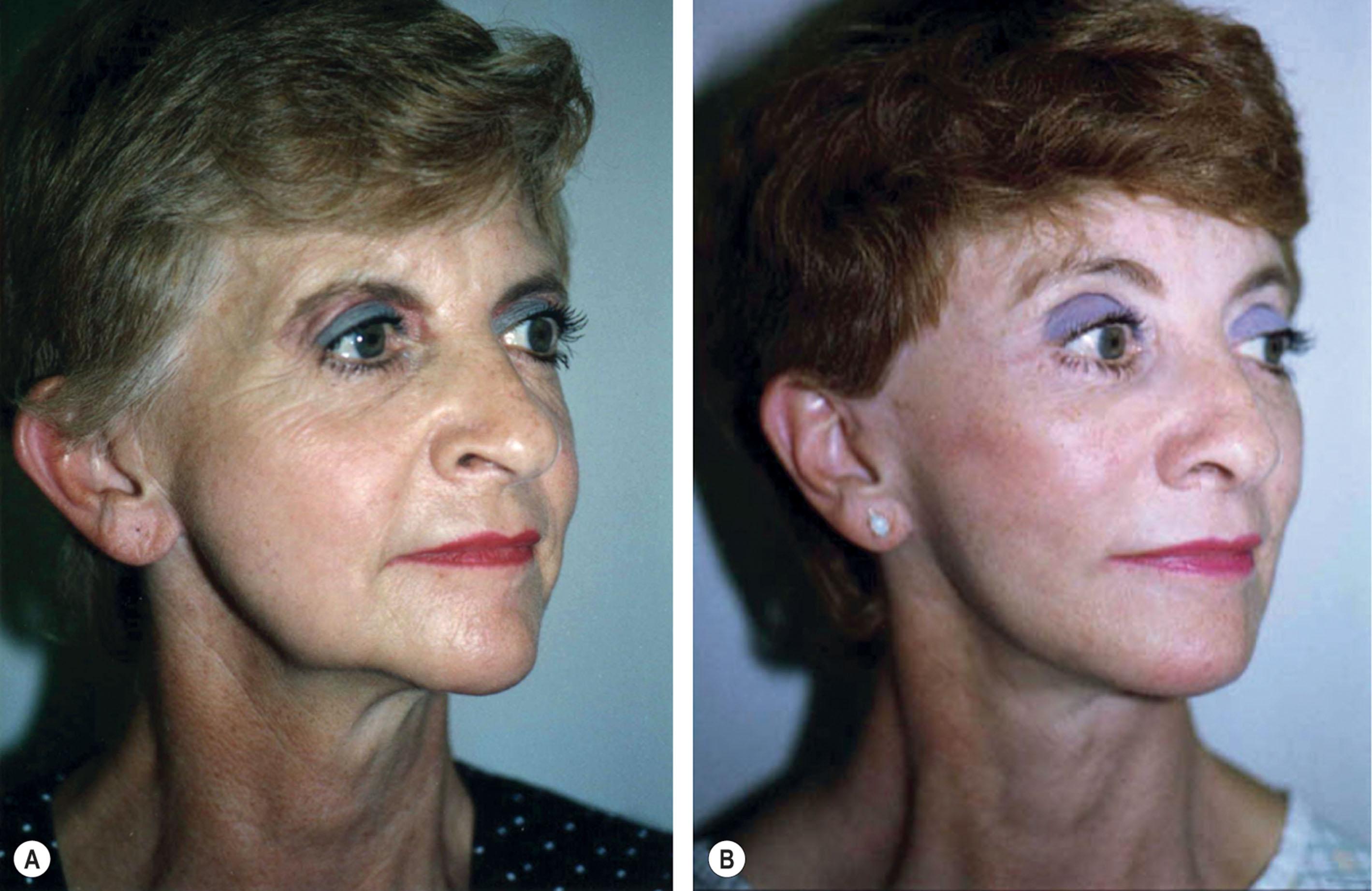
Regrettably, many surgeons have been traditionally taught to perform a limited “tuck” or “touch-up” when performing secondary or tertiary procedures consisting of additional skin excision and skin tightening. This does not address the true underlying problems, however, and typically compounds the secondary irregularities present in many patients.
The number and degree of secondary irregularities present will determine the difficulty of any additional surgery and the overall potential for improvement possible. Typical problems seen in the patient presenting for secondary facelift include hairline displacement, hair loss, poorly situated scars, wide scars, scleral show, eyelid dysfunction, tragal distortion, earlobe distortion, over-excision of cervicofacial fat, distortion and abnormal appearances due to inappropriate tissue shifts, and abnormal appearances when emoting. Less commonly, problems related to nerve injury, skin slough, or other surgical complications may be present. These problems are worth every surgeon’s consideration, even if they perform only the occasional secondary procedure, as they exist as compelling reminders of mistakes to avoid in the planning and performance of any primary procedure.
Hairline displacement and disruption remain predictable outcomes of many currently used facelift incision plans and are a source of disappointment and frustration for patients and surgeons alike. These problems are the result of poor analysis and planning at the time of the primary procedure, and failure to use an incision along the hairline when indicated. Although hairline displacement may be acceptable after some primary facelifts in which incisions were made in the traditional location within hair-bearing scalp, it will almost always be intolerable after a secondary facelift if such an incision plan is used again. For this reason, thoughtful planning of secondary and tertiary facelifts frequently requires the use of incisions placed along hairlines, rather than behind them within hair-bearing scalp.
The placement of an incision and thus the resulting scar along a hairline at secondary surgery represents a choice between two imperfect alternatives but the best overall artistic and aesthetic compromise in most patients. Although incisions made within the hair-bearing scalp produce concealed scars within the hair when properly made and closed, they will result in tell-tale and objectionable hairline displacement in many patients that is usually readily apparent upon casual glance and at a distance. These irregularities are often not subtle and frequently result in an unnatural or even grotesque appearance ( Fig. 9.12.2 & 9.12.3 ; see also Figs. 9.12.6 & 9.12.7 ). In addition, they are uniformly difficult for the patient to disguise and a challenge for the surgeon to correct.
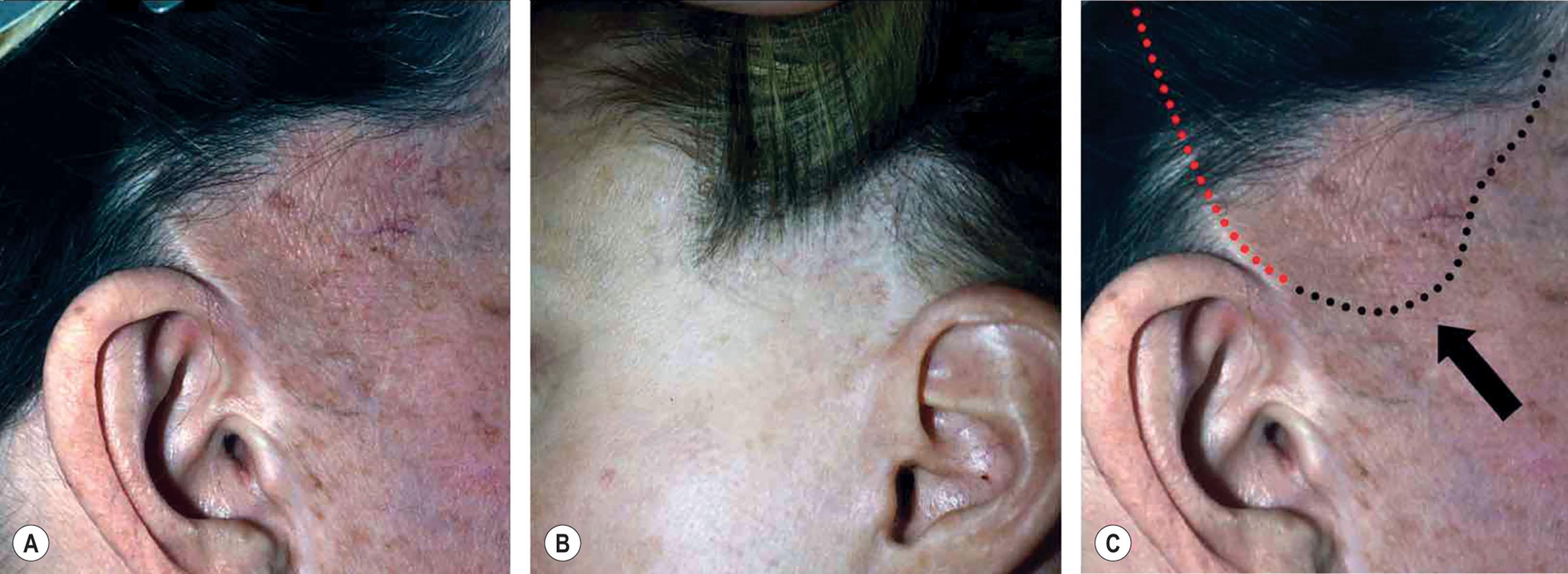
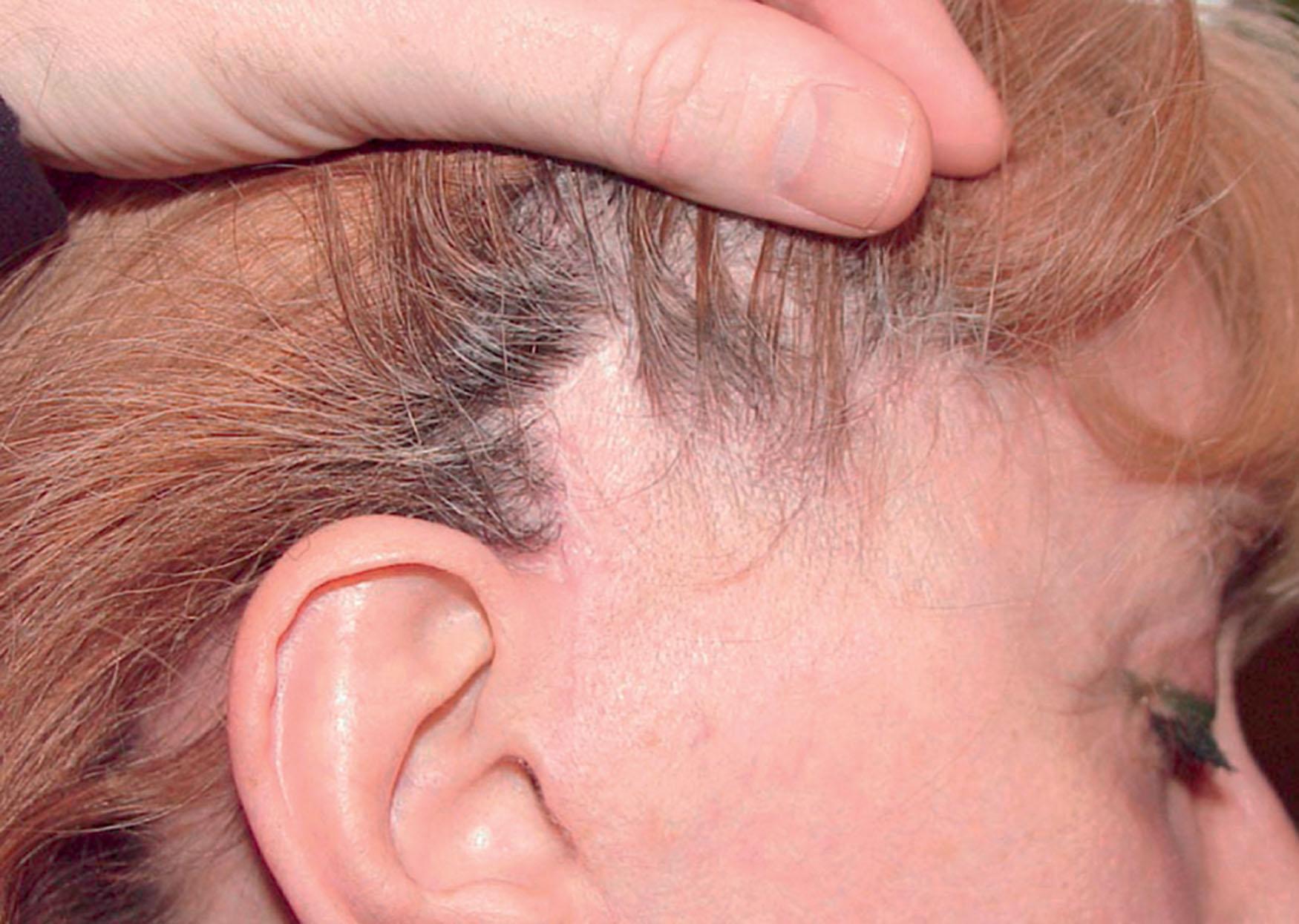
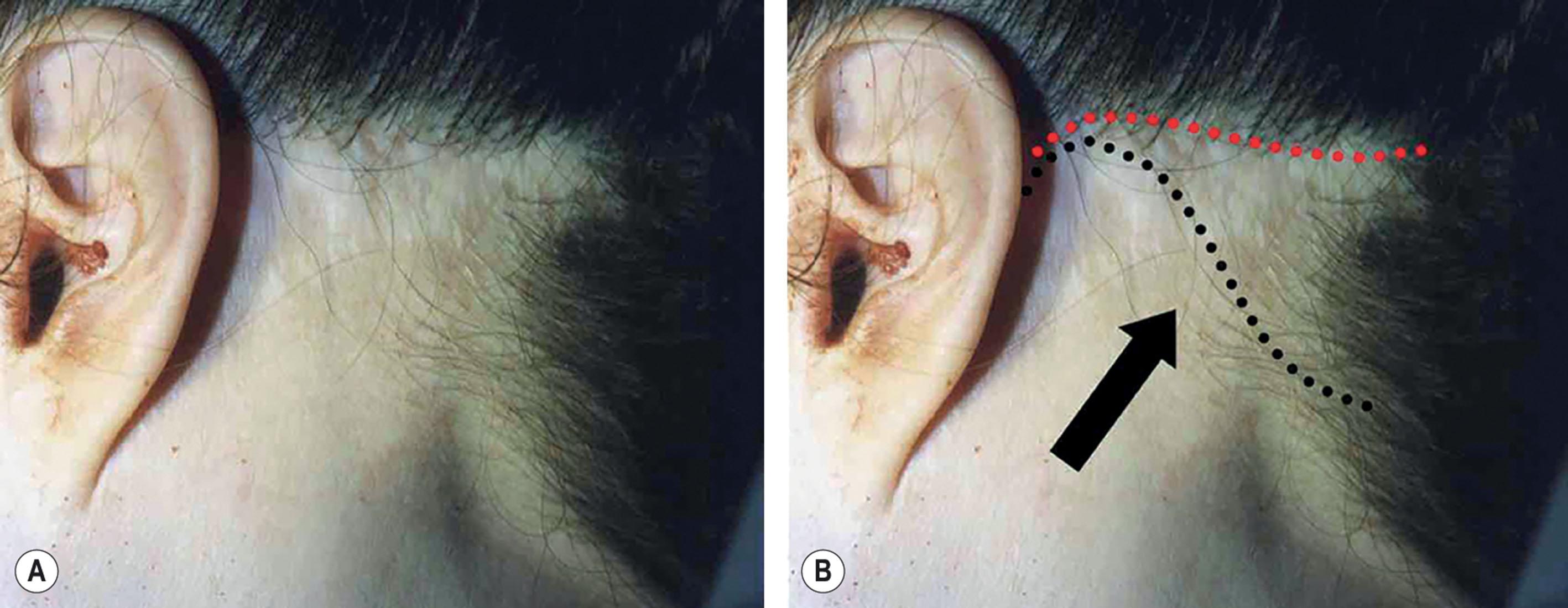
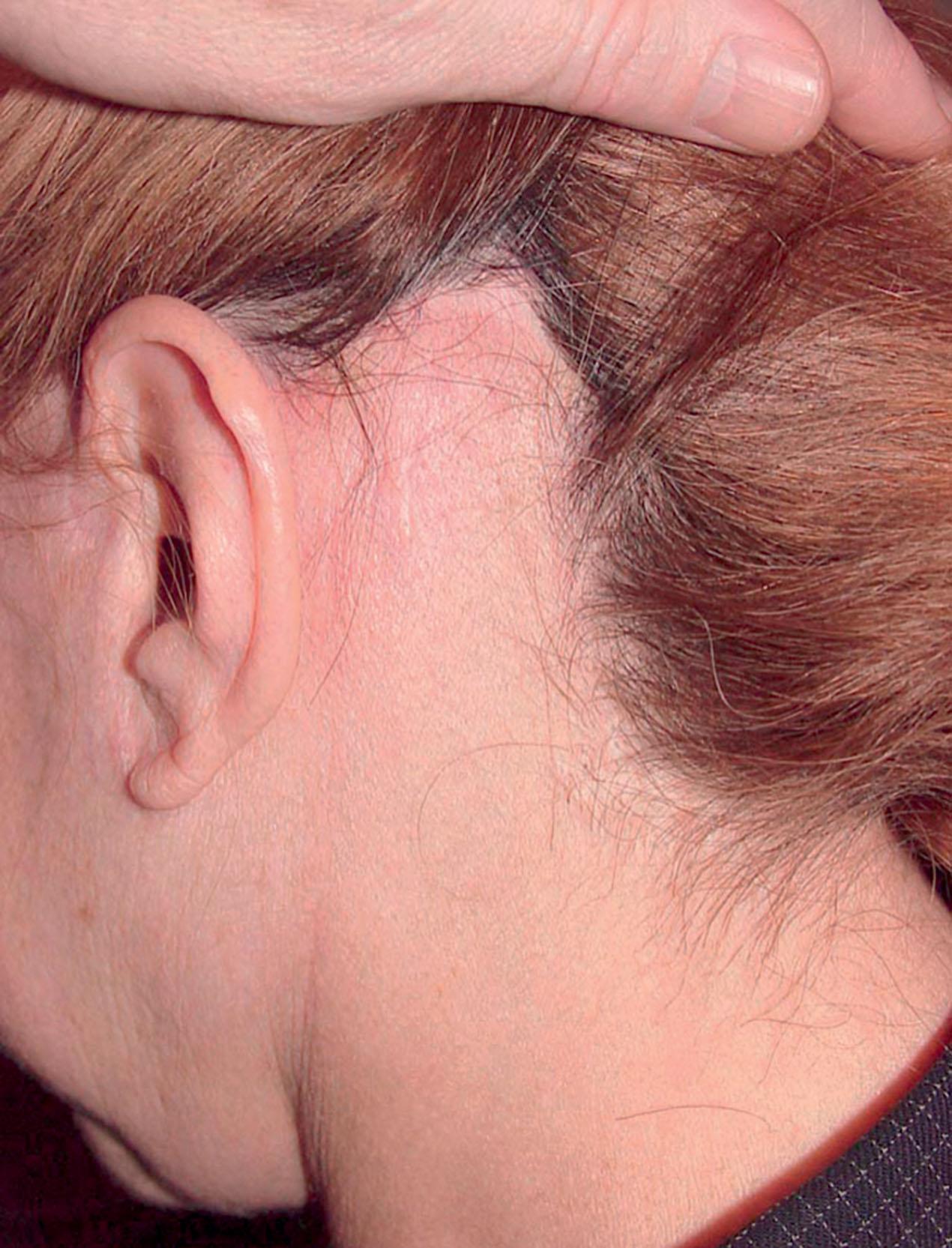
Placing the incision along a hairline, however, usually results in a fine scar only visible on close inspection when correctly planned and proper technique is used. And unlike displaced hair, a scar along the hairline can usually be easily concealed with make-up, if necessary, but generally goes unnoticed in most social situations and casual encounters. Often, they are difficult to detect even on close inspection (see Figs. 9.12.5 & 9.12.9 ). Attempts to disguise displaced hair by combing adjacent hair over these areas is no more effective than the “comb-over” hairstyles worn by many balding men. Although this is perhaps preferable to the patient to having bald spots and missing hair showing, it is immediately evident that the problem is still present in most cases.
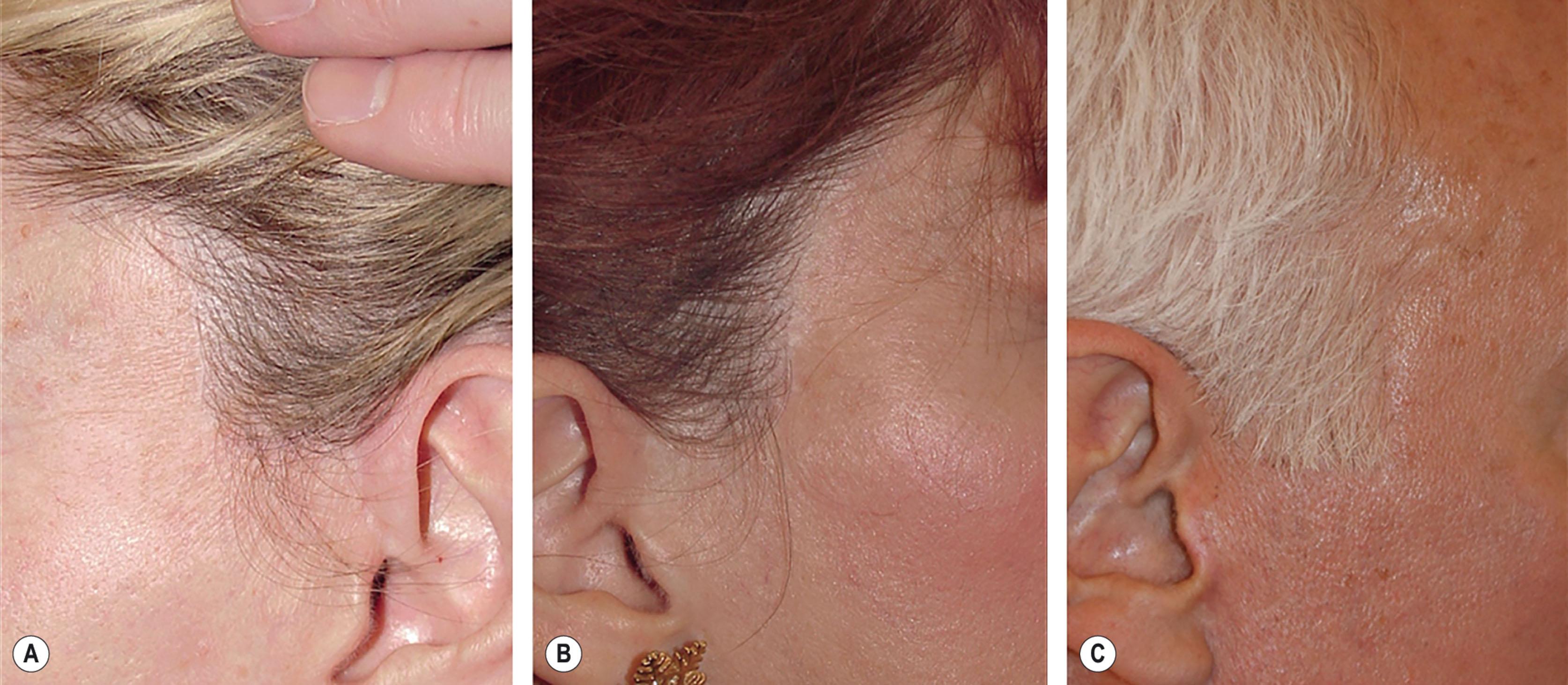
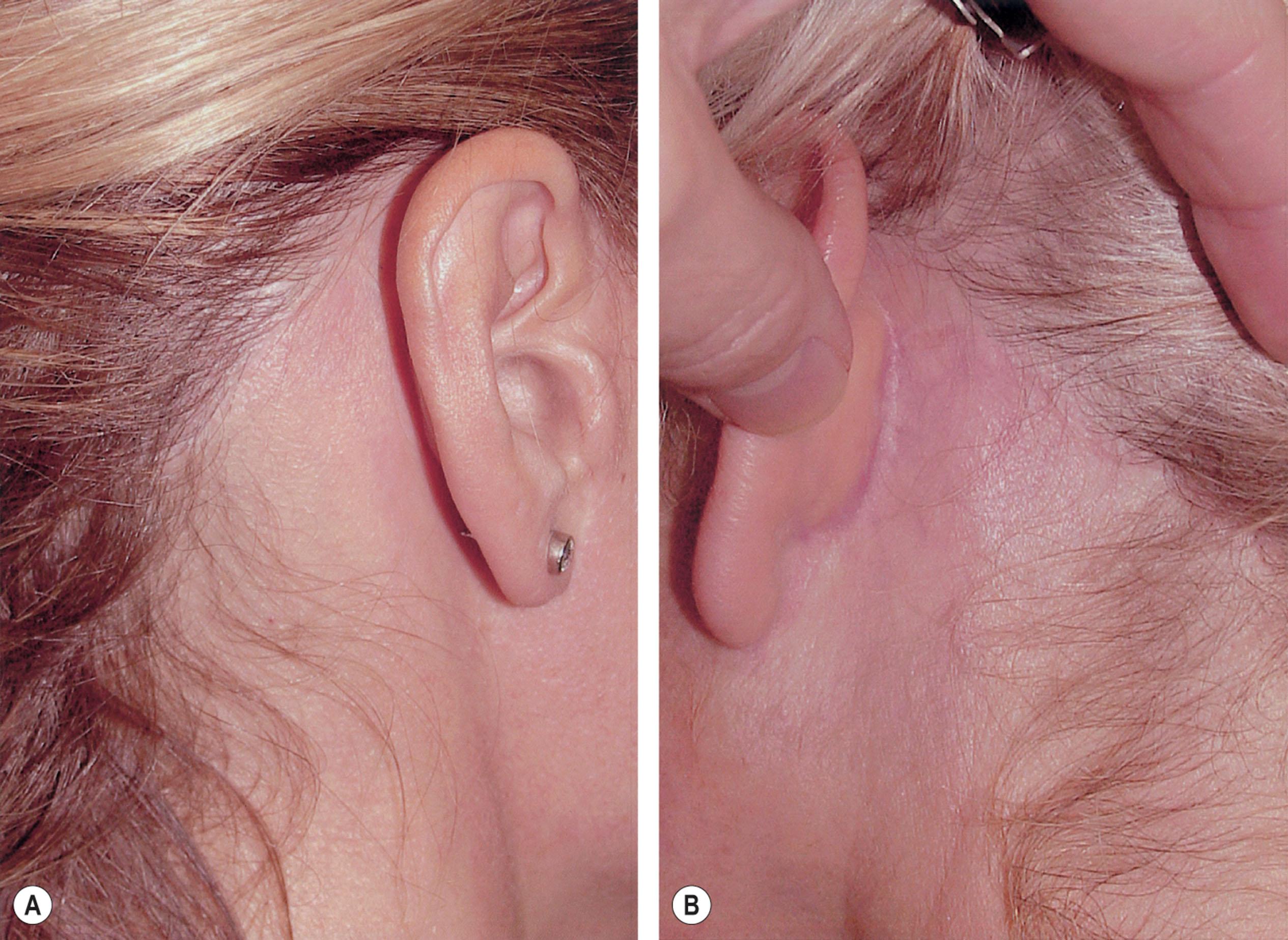
The temporal portion of the facelift incision traditionally placed within the temporal scalp will frequently result in a tell-tale and unnatural-appearing superior elevation and posterior displacement of the temporal hairline. Secondary or tertiary facelifts using the same incision plan will compound this problem and often result in a bizarre-appearing and objectionable absence of temple hair ( Fig. 9.12.3 ).
This can best be minimized or avoided at secondary facelift by the use of an incision along the hairline ( Fig. 9.12.4 ).
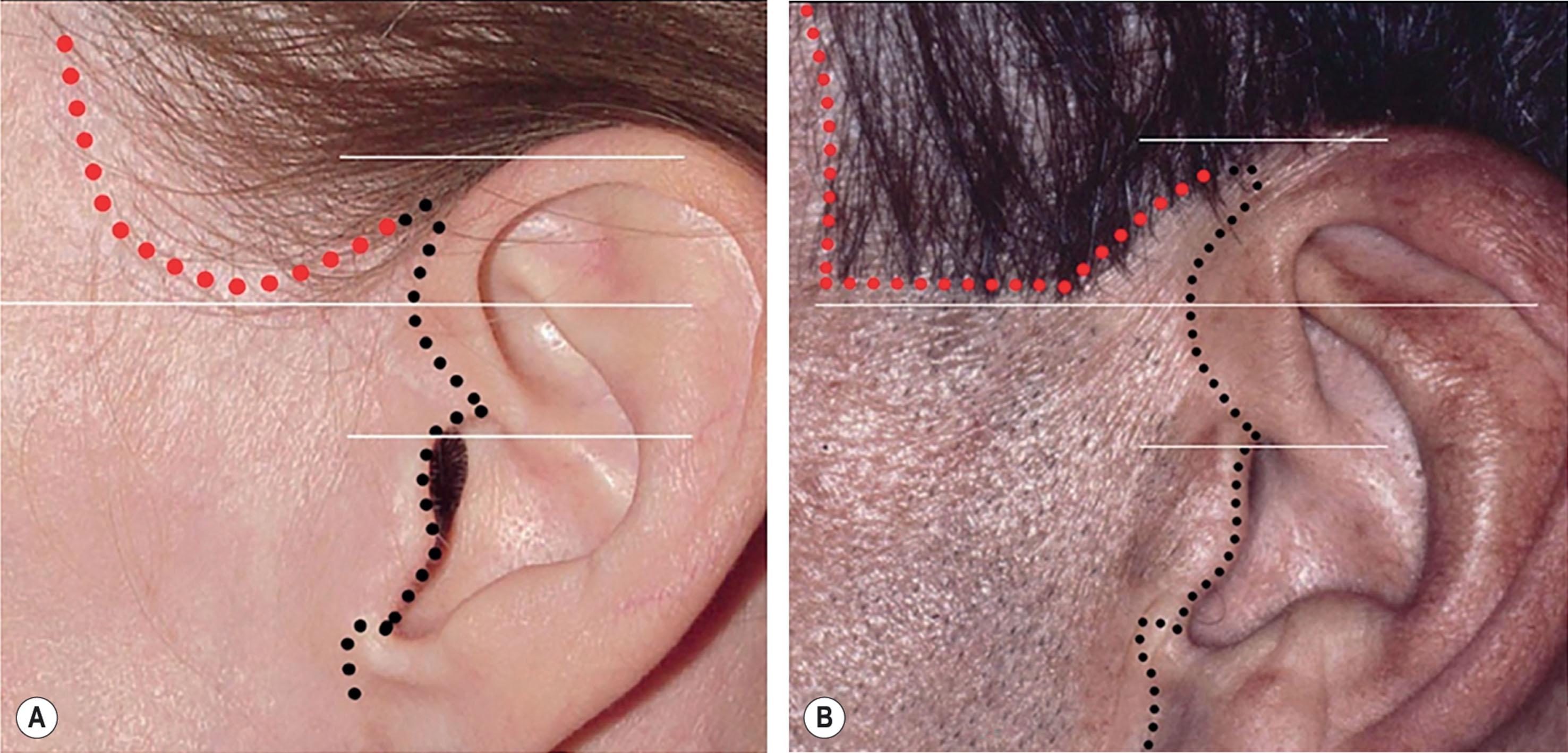
If it is appropriately planned and carefully executed, an acceptable scar will result that is artistically and aesthetically superior to additional hairline displacement ( Fig. 9.12.5 ).
The occipital portion of the facelift incision is traditionally placed high up on the occipital scalp, in a well-intended, but almost always counter-productive effort to hide the resulting scar. Unfortunately, any such a plan embodies an inherent defect in design that will preclude optimal improvement in the neck and frequently result in a tell-tale and unnatural appearing displacement of the occipital hairline ( Fig. 9.12.6 ).
A high transverse post-auricular incision plan presumes that the resultant vector of skin redundancy is directed mostly superiorly and that the majority of skin redundancy is present over the lateral neck. Both careful consideration and direct observation will reveal the proper direction of postauricular flap shift to be in a mostly posterior , slightly superior direction that roughly parallels the mandibular border if an optimal result is to be achieved in the anterior neck and submental area. This is because it is along this vector that the majority of neck skin redundancy is present. As the flap is shifted along a more superiorly directed vector, as it must be with any high transverse occipital incision plan, a diminished effect will be seen over the anterior neck and submental regions. In addition, transverse cervical skin wrinkles, if present, will be unnaturally shifted superiorly up over the lower lateral face and the prelobular and postauricular areas. It must also be kept in mind that neck contour should be achieved as the result of deep-layer neck maneuvers and repair, and not skin tightening. As such, neck skin should be shifted and excised along a vector that allows maximum elimination of skin redundancy, and not one that appears to produce the most neck tightness.
Although occipital hairline displacement may sometimes be acceptable to patients after their primary procedure, secondary or tertiary facelifts using the same incision will compound this problem and usually result in an unnatural and intolerable absence of occipital hair and notching of the occipital hairline ( Fig. 9.12.7 ).
If an attempt is made to reconstitute the hairline by superior shifting of the post auricular flap, a wide transmastoid scar will usually result as the tissue discarded in any such maneuver is necessary for side-to-side head tilt and shoulder drop when the patient is in an upright position. These problems can best be minimized at the time of secondary facelift by the use of an incision along the occipital hairline to prevent further hairline displacement ( Fig. 9.12.8 ).
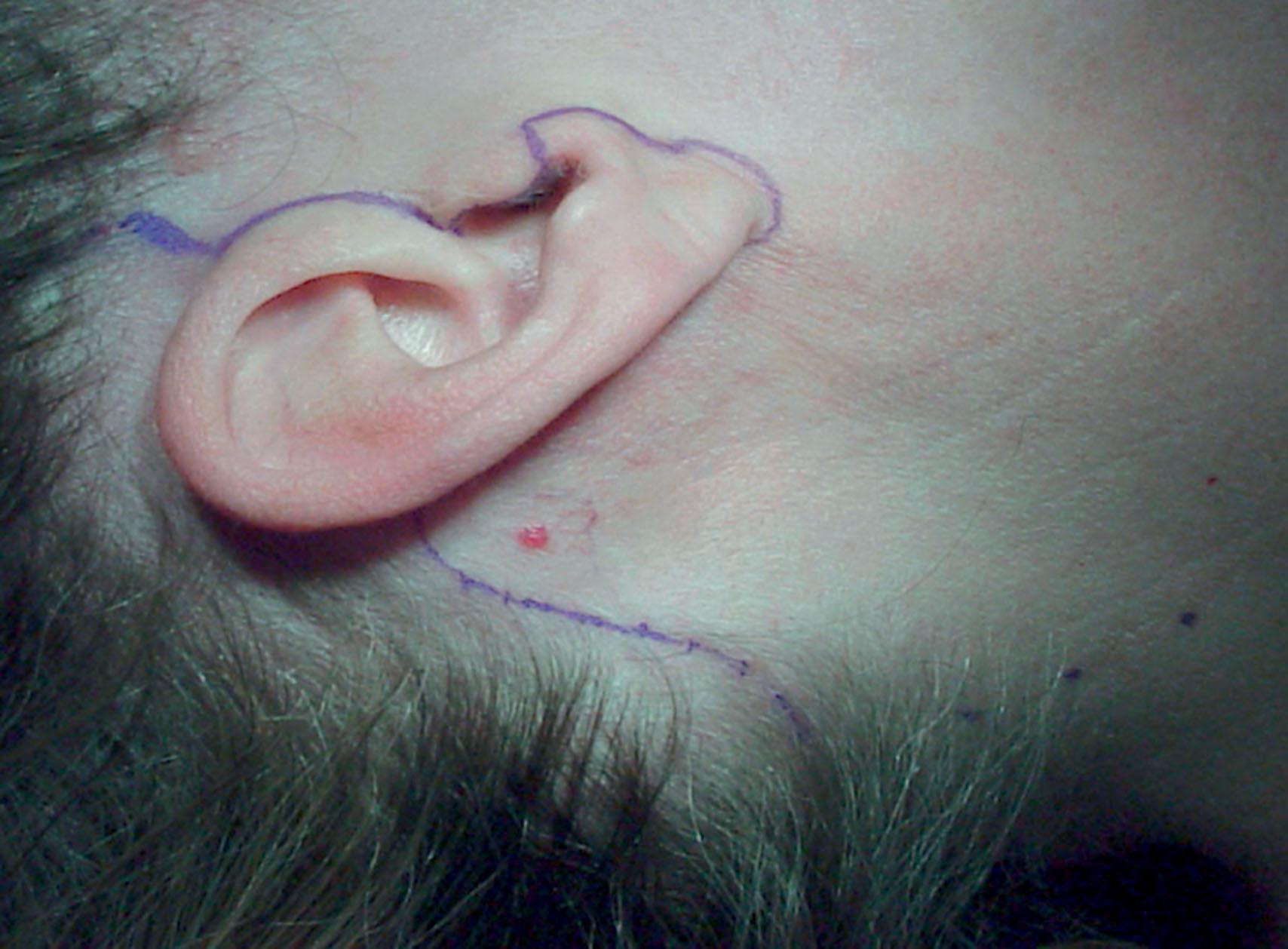
If the incision is appropriately planned and carefully executed, an acceptable scar will result that is artistically and aesthetically superior to additional hairline displacement ( Fig. 9.12.9 ). In addition, this plan will sometimes allow scalp displaced at the primary procedure to be partially advanced back towards its proper position.
When an incision is used along the occipital hairline, it should be planned in such a way that the inferior portion of the incision and thus the resulting scar is turned back into the scalp and at the junction of thick and fine hair on the nape of the neck see Fig. 9.12.8 . It should not be carried more inferiorly because it will be incompletely concealed and is likely to be visible to others ( Fig. 9.12.10 ).
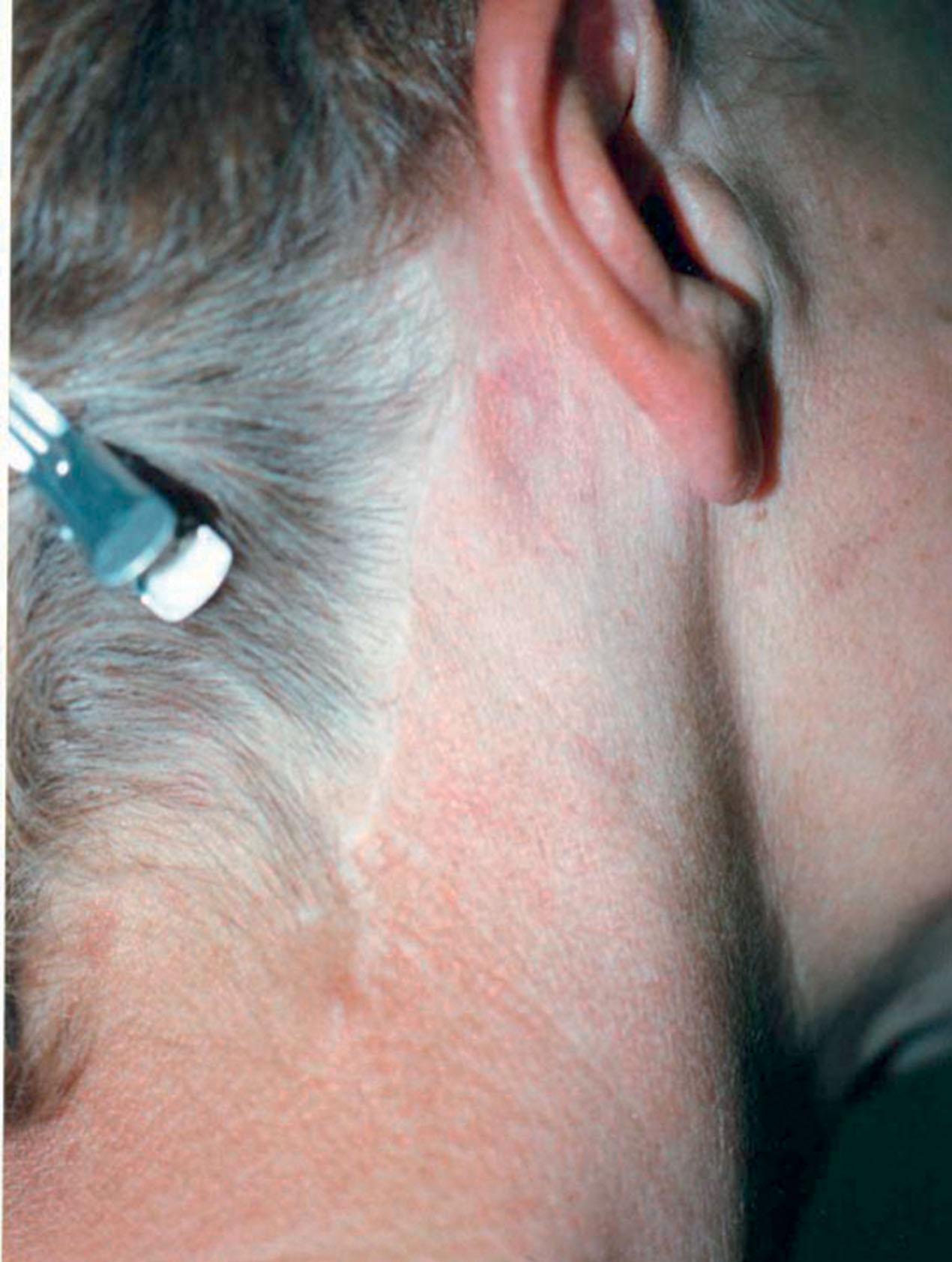
Fundamental to obtaining an inconspicuous, well-healed scar when incisions are placed along the temporal or occipital hairline is the diversion of tension to deeper tissue layers (SMAS and platysma) and precise skin flap trimming so that wound edges abut each another under no tension before sutures are placed. The incision is then closed using a combination of half-buried vertical mattress sutures of 4-0 nylon with the knots tied on the scalp side and multiple simple interrupted sutures of 6-0 nylon. The 6-0 sutures provide precise wound alignment and are removed in 5 days. The half-buried vertical mattress sutures of 4-0 nylon provide wound support, while simultaneously avoiding cross-hatched marks. These sutures are removed 7–10 days after surgery.
Although incisions placed along the frontal, temporal, and occipital hairlines will prevent additional hairline displacement at a secondary procedure, they do not provide for correction of large and severe problems sometime seen (see Figs 9.12.2, 9.12.3, 9.12.6, & 9.12.7 ). In these situations, consideration must be given to the use of hair flaps, hair transplantation, and scalp expansion, with hair transplantation usually being the most effective treatment.
Hair loss is an all too common and largely avoidable stigma of facelift surgery seen in many patients presenting for secondary procedures. Hair loss is generally the result of technical errors, including improperly made incisions that damage hair follicles, placement of overly tight sutures, or the closure of inadequately mobilized scalp flaps under too much tension. It may occur, however, in smokers, certain individuals with scalp disease (alopecia areata), eating disorders, or patients with a variety of systemic illness in the absence of any errors or wrong-doing on the part of the surgeon. Consideration should be given to an origin of this sort before hair loss experienced by the patient at the primary procedure is attributed to technical error. Hair loss is also frequently the result of the ill-conceived shifting of scalp flaps along the wrong vector. This is commonly seen on the temporal scalp after erroneous attempts to smooth the forehead and glabella by applying lateral traction on the forehead flap ( Fig. 9.12.11 ).
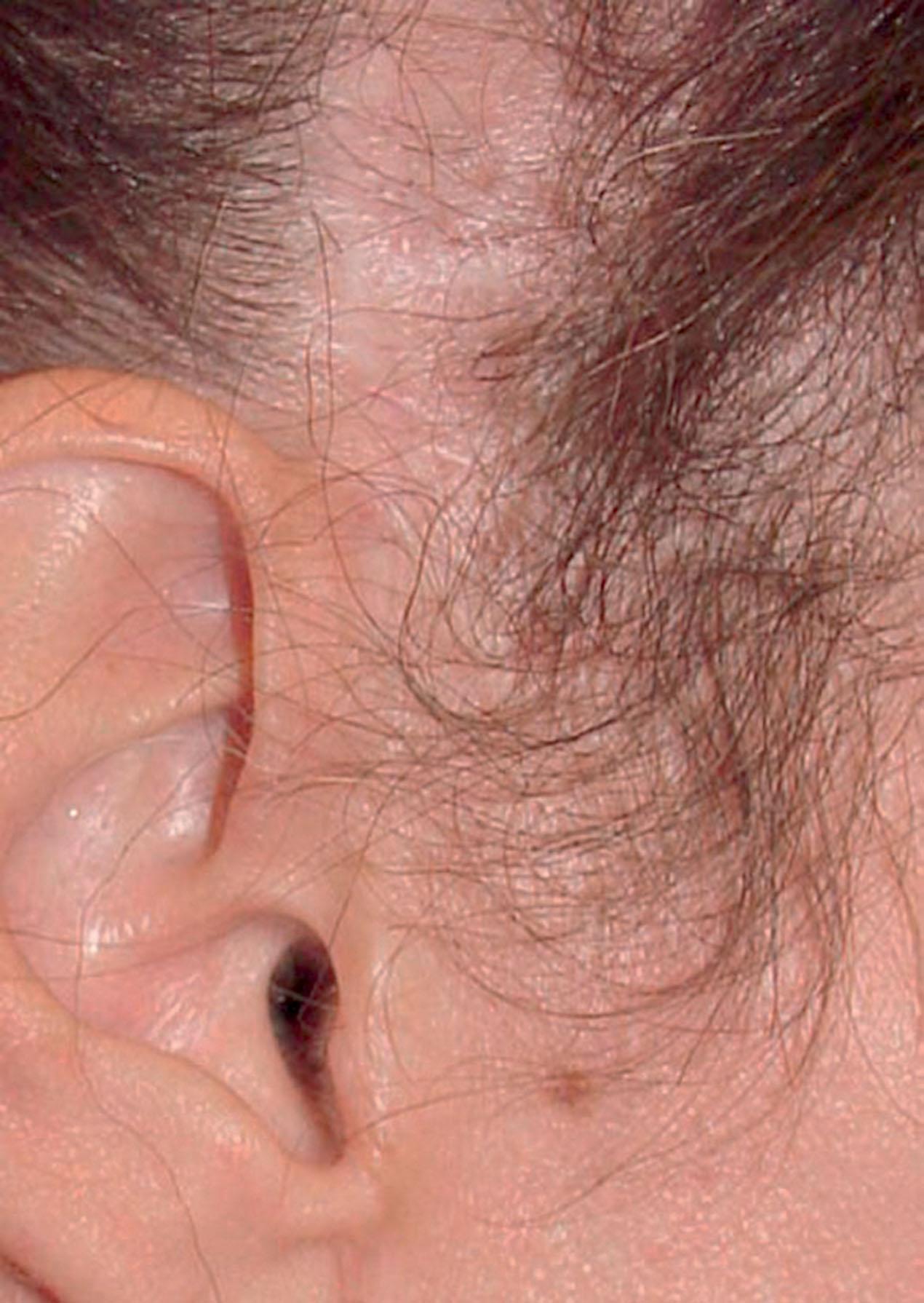
The use of cautery near or within the plane of hair follicles can also result in hair loss, as can rough flap handling and pinching or prolonged folding of scalp flaps beneath retractors.
Small areas of hair loss resulting from tight suture placement or attempts at spot suspension of the scalp can often be corrected at the time of secondary facelift by direct excision after adequate mobilization of surrounding tissue or by incorporation of the hairless area into a more comprehensive incision plan ( Fig. 9.12.12 ).
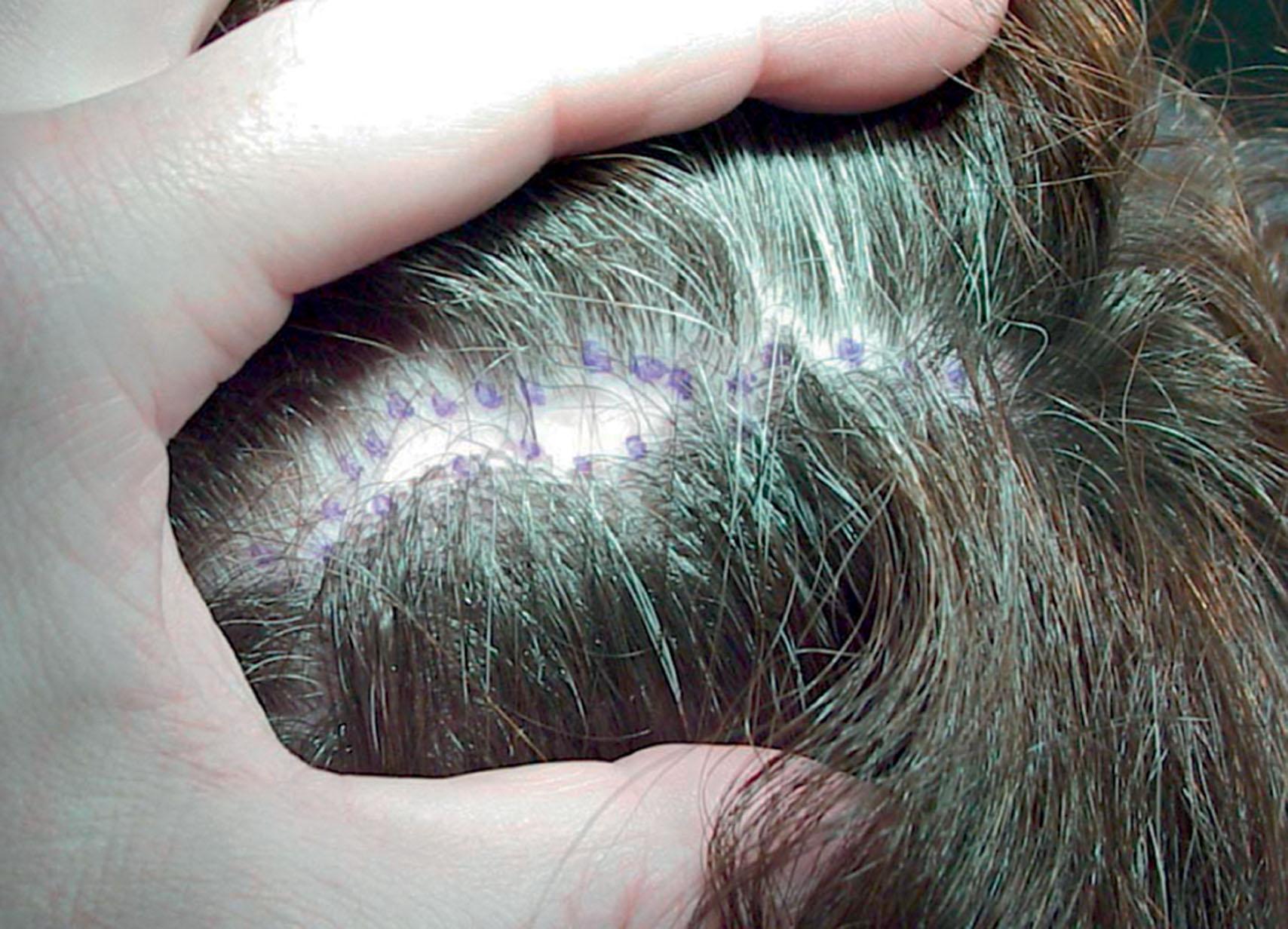
Larger areas of hair loss resulting from excessive flap tension, an overly tight closure or ill-conceived scalp flap shifting are usually much more difficult to correct, especially if scalp excision was aggressive at the primary procedure and little residual redundancy is present ( Fig. 9.12.13 ). In such instances, the patient and surgeon must accept that complete correction may not be possible at the time of secondary facelift and that hair transplantation, scalp flaps, or scalp expansion may be necessary at a later date. An important goal at any secondary procedure in these patients is to select a surgical plan that does not further compound the problem, and that might still provide some improvement.
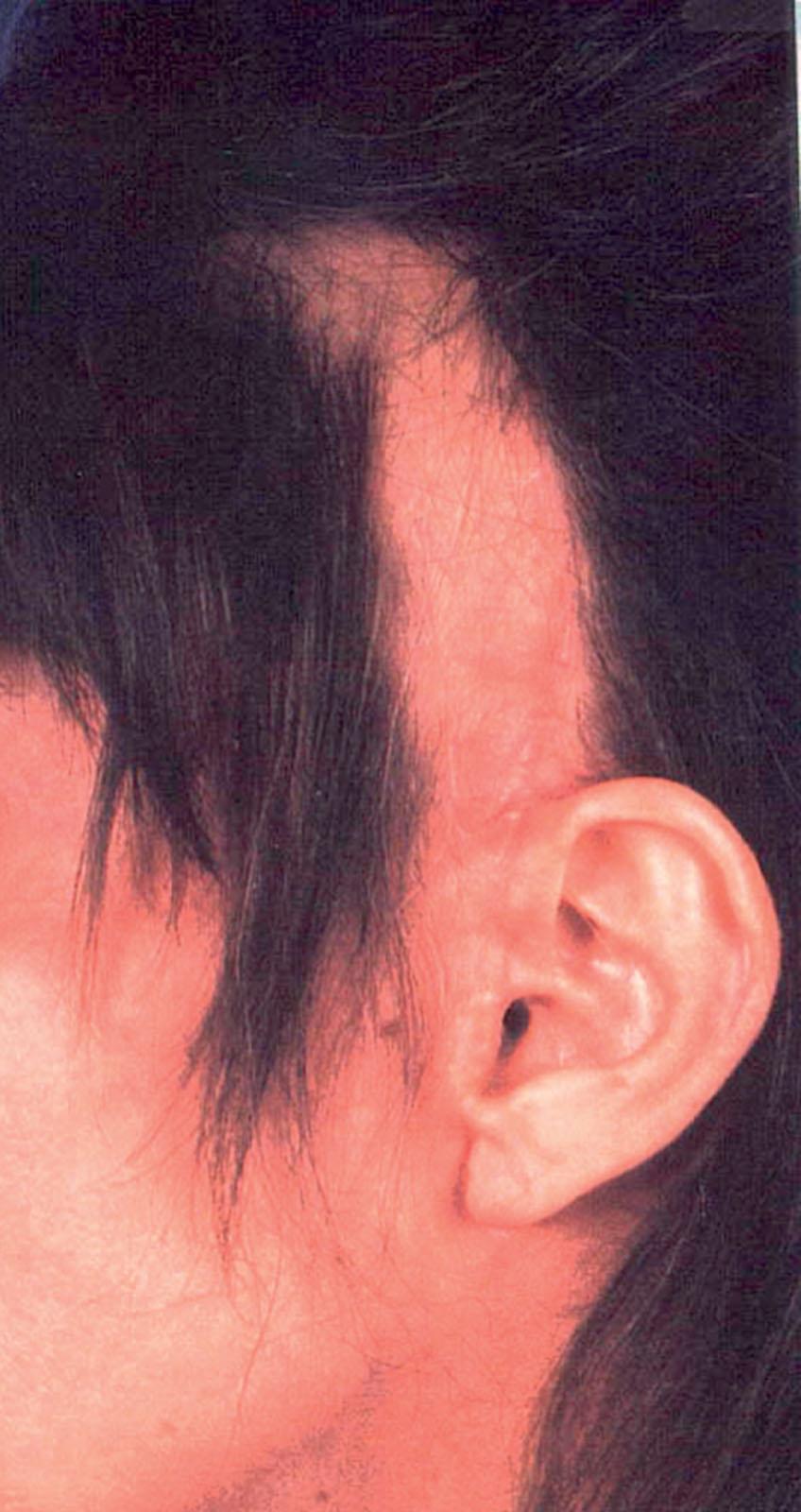
Poorly sited scars are a common problem after primary facelift and the result of artistic insensitivity, poor planning, and tension-based surgical techniques. In many patients, a secondary facelift will provide the opportunity to relocate these to a more appropriate, less conspicuous location, but in others it must be recognized and accepted that complete correction is not possible if additional problems are to be avoided.
Poorly situated scars are typically seen in the preauricular, perilobular, and postauricular areas. They can also be found in the submental region in many patients. Proper placement of incisions is important, particularly in the preauricular area, because even a thin, well-healed scar will ultimately be visible and noticed by others, in most cases as a result of the gradient of skin color and texture typically present on each side of it. Although differences in skin color can sometimes be concealed with make-up, differences in texture usually cannot. Scars placed along natural anatomic interfaces tend to be overlooked by the eye, however, where a gradient of color and texture is expected to be seen and where the scar appears to be a natural crease on the face ( Fig. 9.12.14B,C ). Make-up becomes less necessary as the scar is lost in shadow, appears to be a natural part of the face, or is mistaken to be a reflected highlight ( Fig. 9.12.14A ).
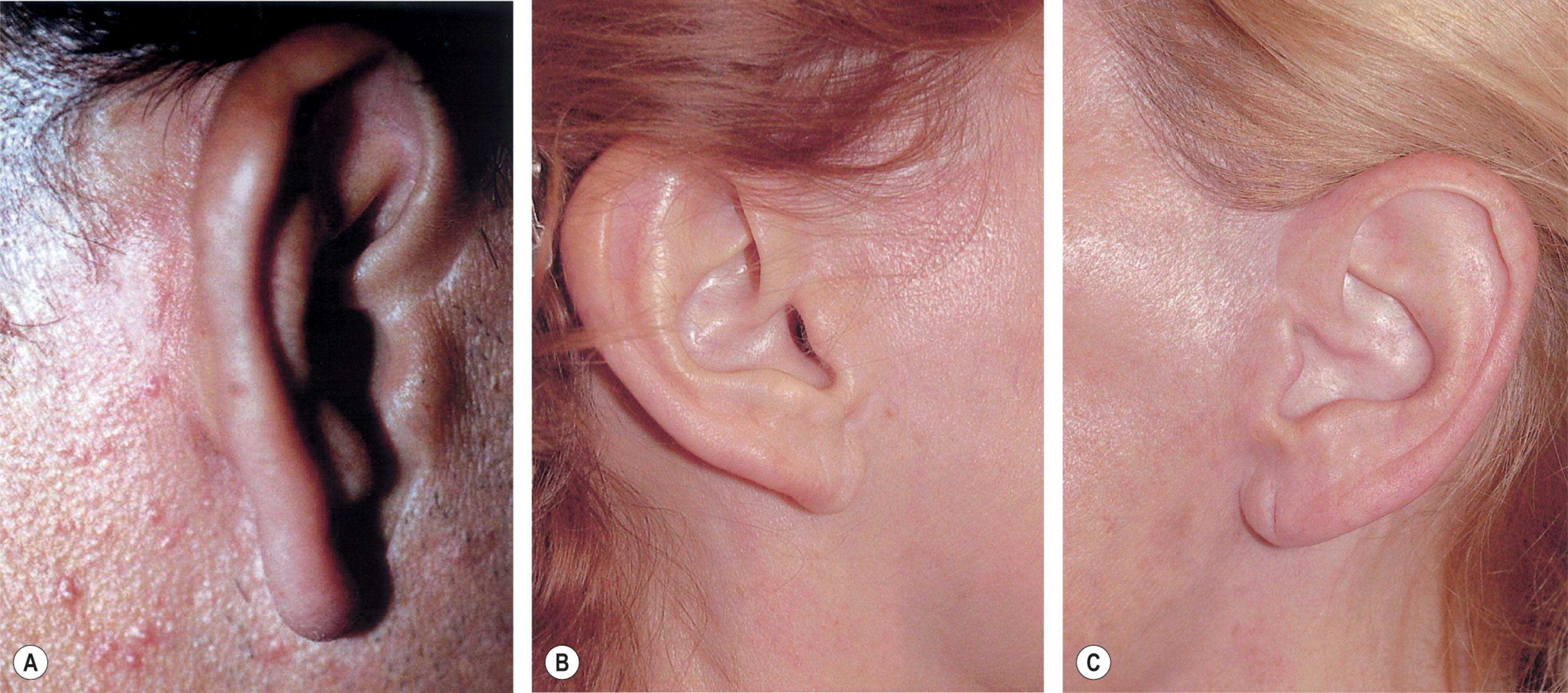
The preauricular region is a common point of reference for those seeking to identify the facelift patient, and, as such, it is of concern to patients and worthy of careful consideration by the surgeon. The pre-helical portion of the preauricular scar is often situated too far anteriorly in the patient presenting for secondary surgery and the illusion of the scar as an anatomical feature is lost ( Fig. 9.12.15A ). Moving this scar so that it rests in the helical–facial sulcus will result in a less conspicuous scar and a more natural appearance ( Figs. 9.12.14 & 9.12.15C ). This is generally possible in most secondary and tertiary cases if skin resection has not been overly excessive at prior procedures (see Fig. 9.12.18 ). The pre-helical portion of the preauricular incision should be planned as a soft curve paralleling the curve of the anterior border of the helix. This will result in a natural appearing "width" to the helix in keeping with the rest of the ear and the resulting scar, if visible, will appear to be a helical highlight and will be disguised as the natural transition between the smooth pinker skin of the helix and the coarser paler skin of the cheek (see Fig. 9.12.15C & Fig. 9.12.16 ).
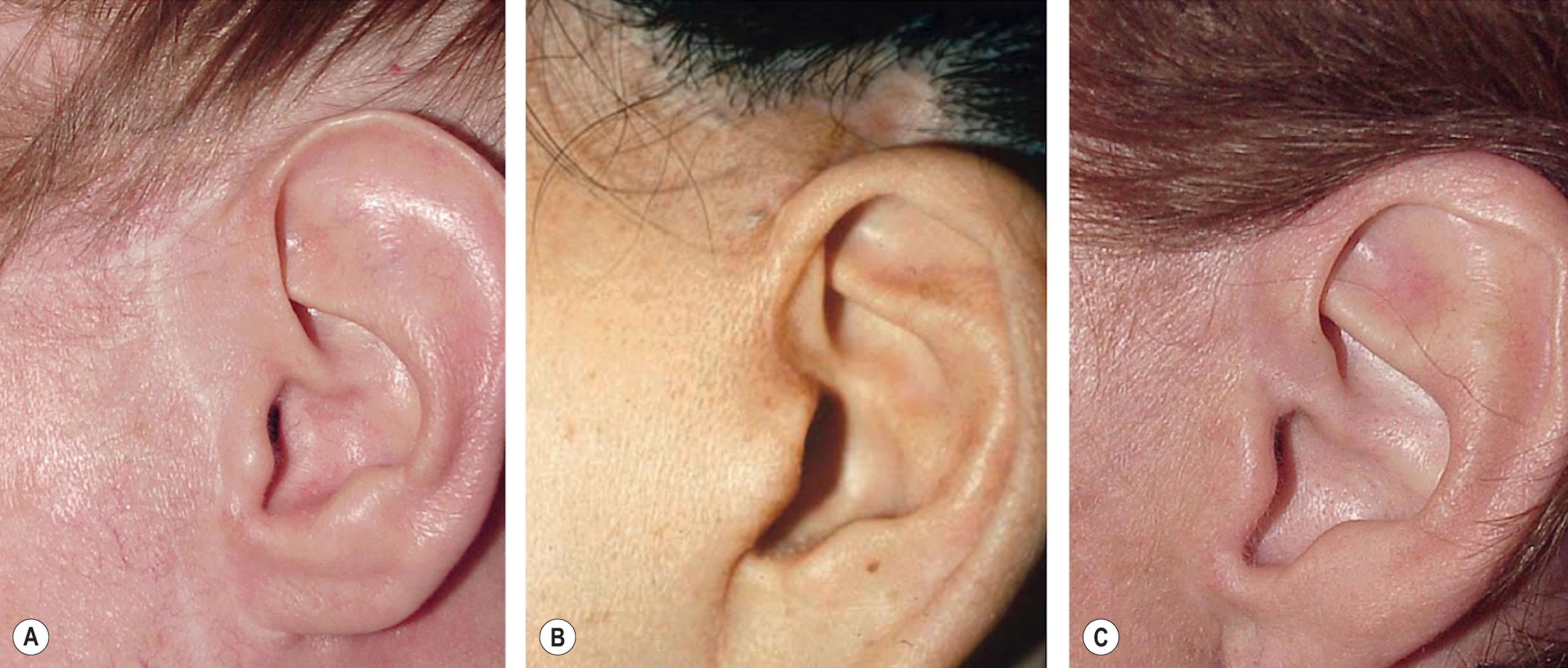
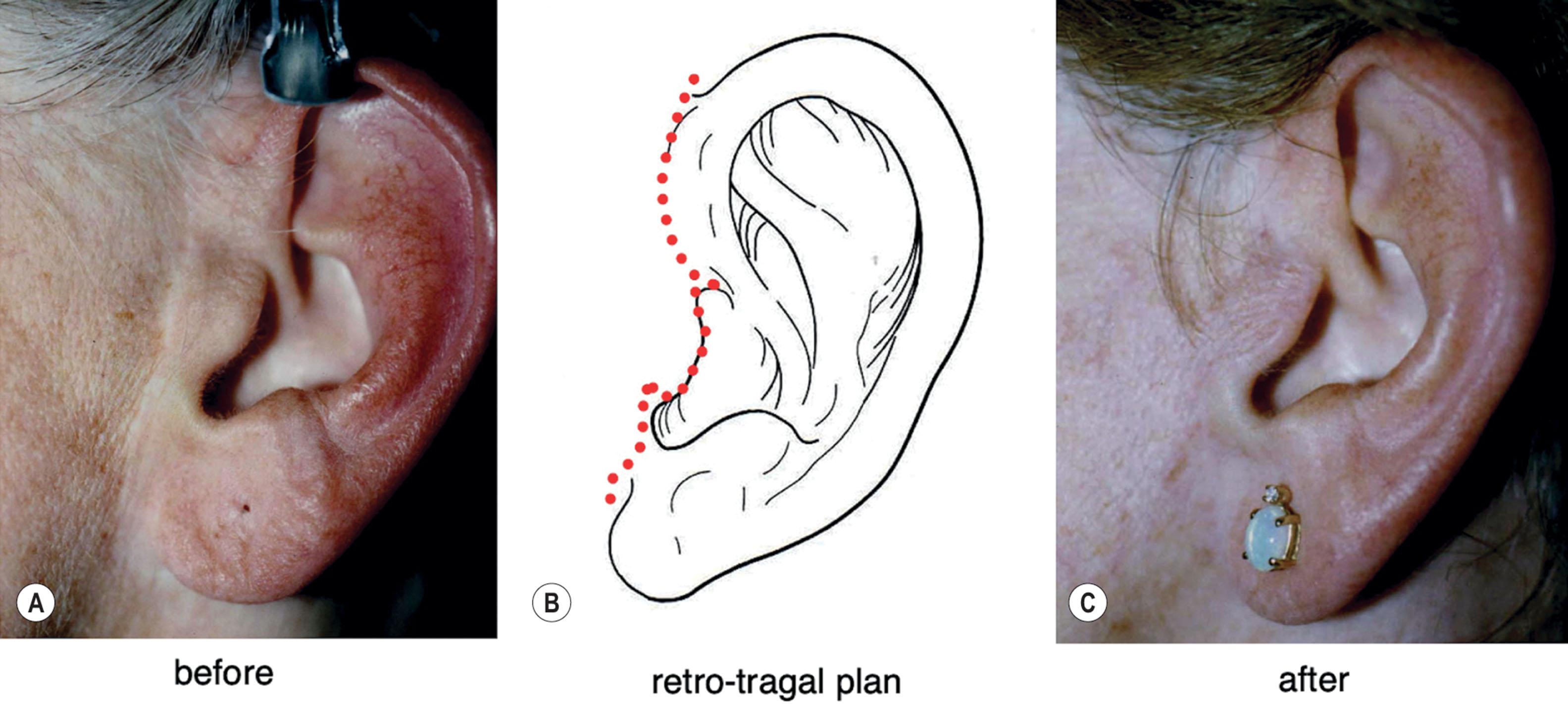
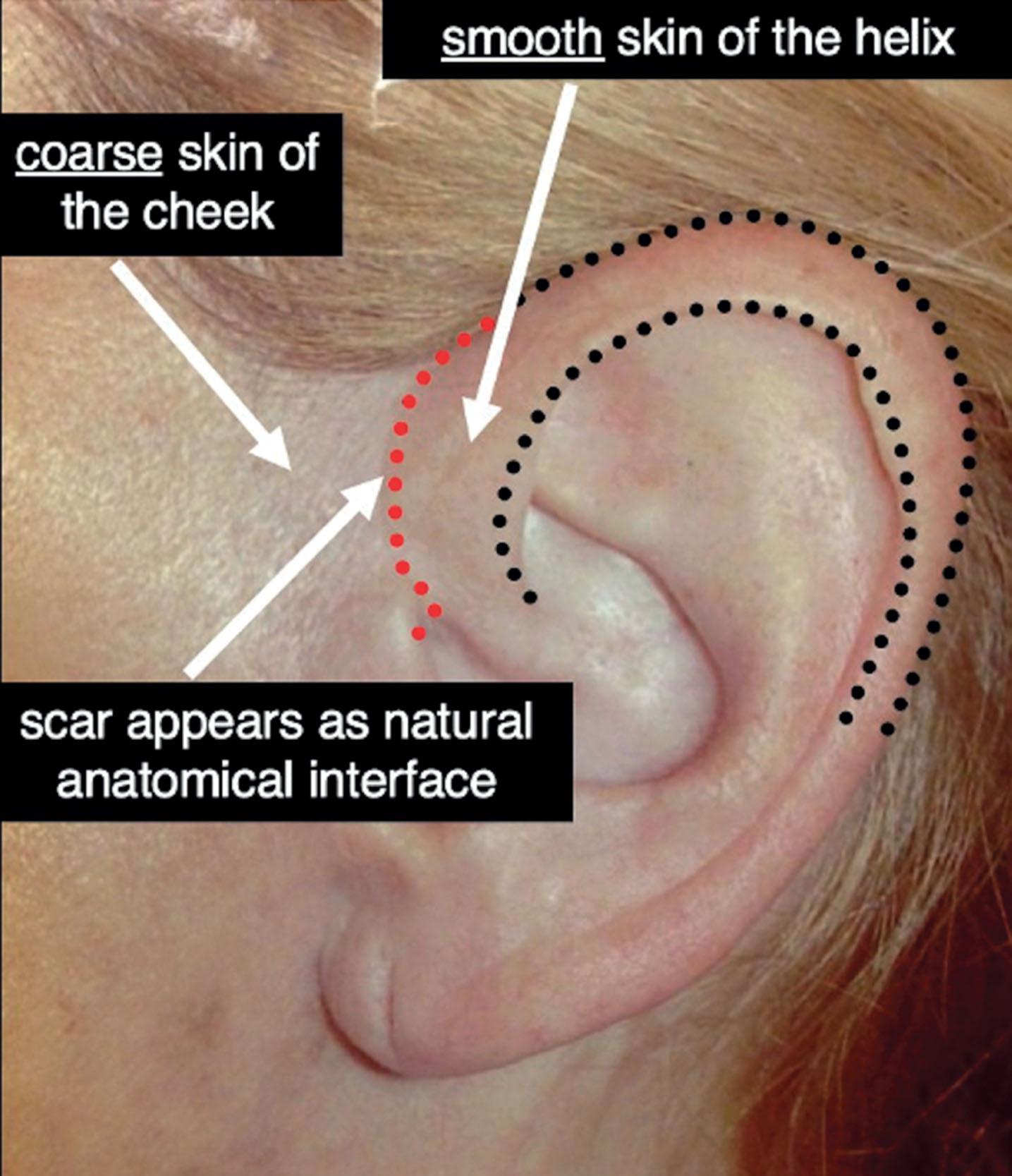
Although it is not possible to move a pretragal scar to a “retro-tragal” position along the posterior margin of the tragus in every patient presenting for secondary surgery, this is preferred when possible, for the reasons outlined above (see Fig. 9.12.18 ). The feasibility of relocating a pretragal scar to a retro-tragal position will depend on the amount of cheek skin redundancy that remains after the primary procedure. Because preoperative assessment of residual cheek skin redundancy can be difficult and exceedingly deceptive at the tragus, it is best in some cases to make the initial incision in a modified pretragal location ( Fig. 9.12.17 ). The decision to sacrifice the remaining skin over the tragus and move the scar to the tragal margin can then be delayed until after cheek flaps have been mobilized, SMAS advanced and anchored, and the actual amount of cheek skin recruited through these maneuvers that is available, if any, is determined. Often, skin recruited is needed to recreate an absent pretragal sulcus and to correct a “buried tragus” irregularity (see Fig. 9.12.27B ). In such instances, relocation of a pretragal scar to the margin of the tragus will not be possible and a pretragal location of the scar must be accepted.
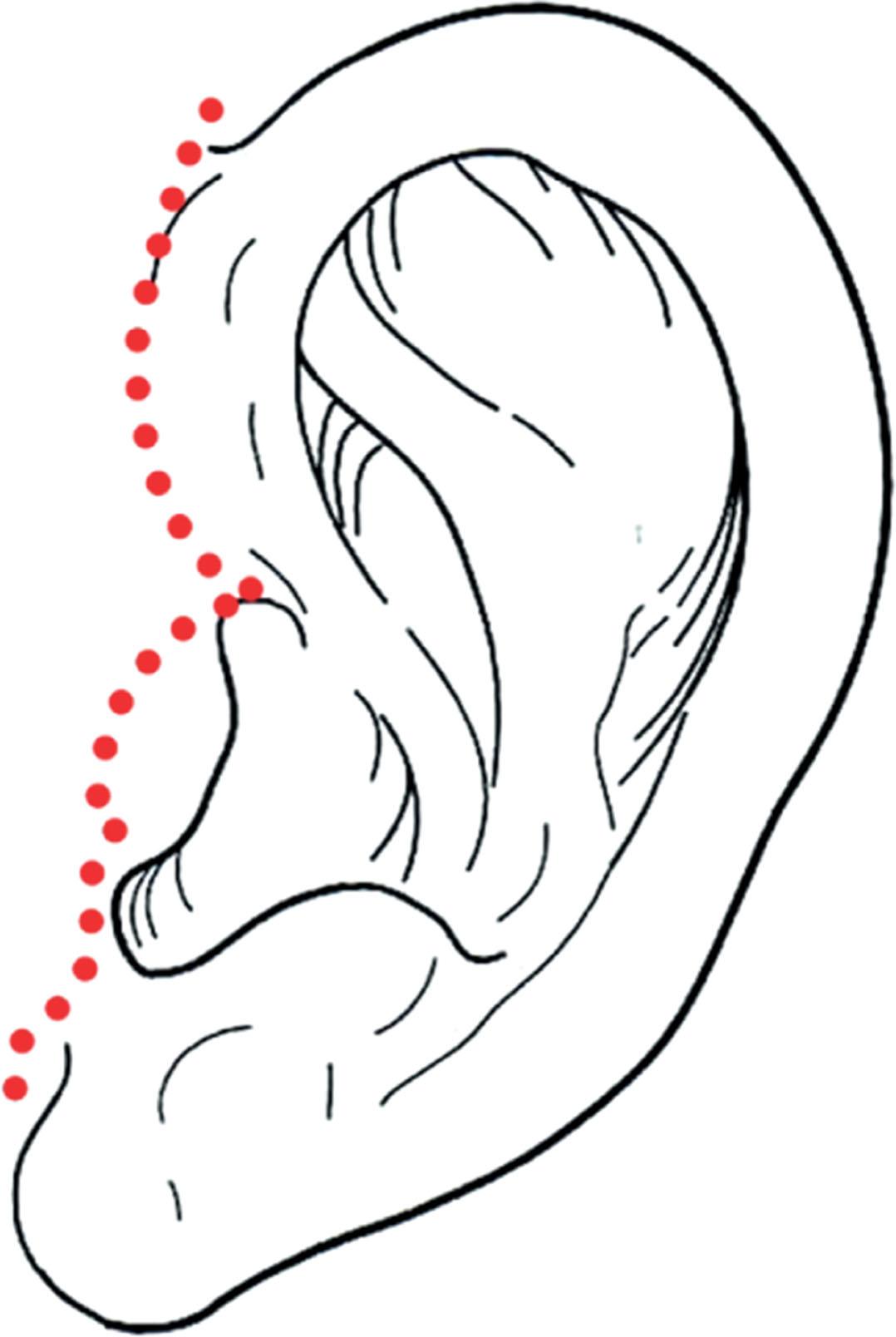
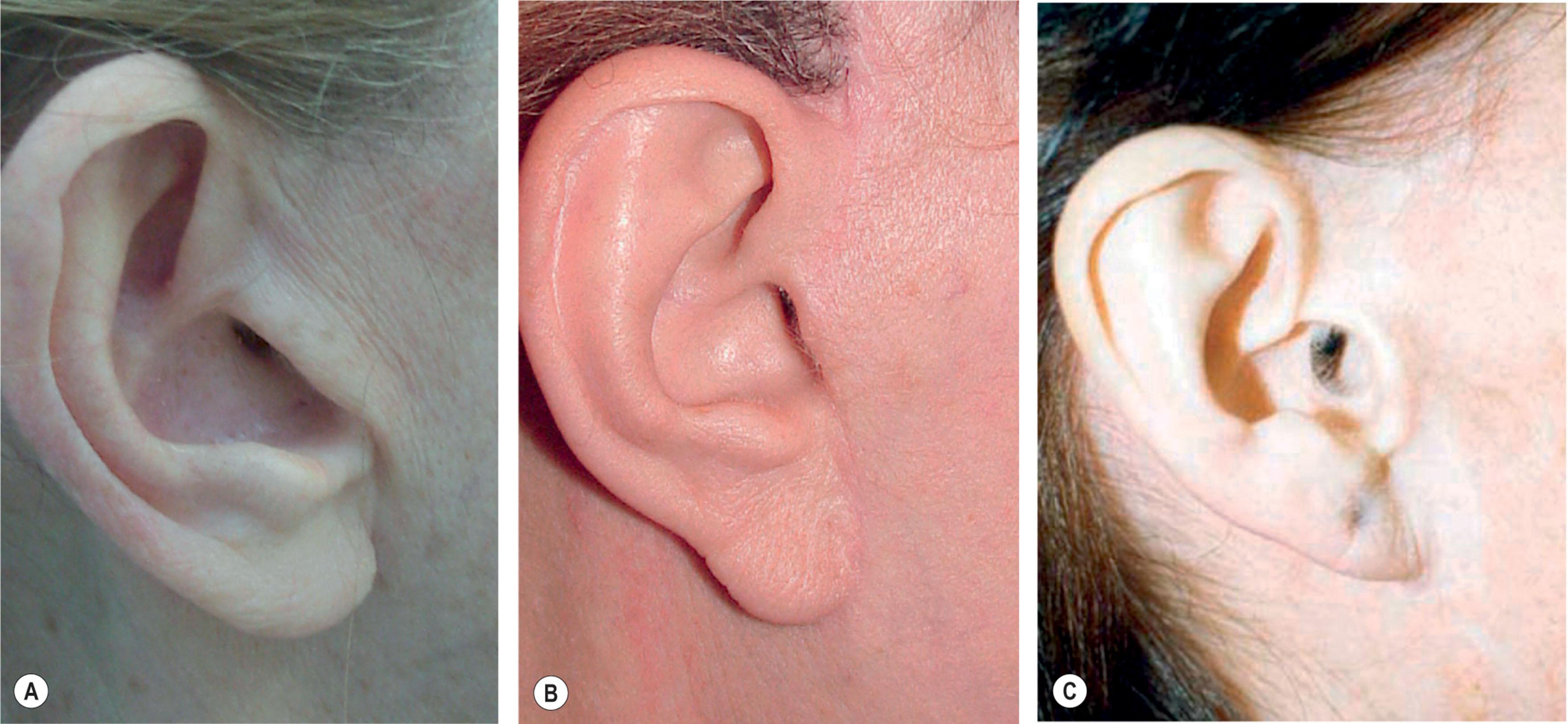
Although it is typically best to plan the preauricular incision in a retro-tragal location (see Figs. 9.12.14 & 9.12.18 ), if inadequate cheek skin is available to recruit for the repair, a defect will be created that will be difficult to properly close. In such cases the modified plan can be used (see Fig. 9.12.17 ). If adequate skin can be recruited, the island of skin on the tragus can be excised and the scar sited in a retro-tragal location. If inadequate skin is recruited to move the scar to a retro-tragal location, this incision plan will typically result in a satisfactory, albeit suboptimally, situated scar.
If the secondary facelift incision is initially made along the margin of the tragus when a pretragal scar is present but before intra-operative assessment of skin redundancy is made, tragal skin may be erroneously excised. This will force an inappropriately tight closure and result in tragal distortion, tragal retraction, and obliteration of the pretragal sulcus.
The perilobular area is a common location in which one can find a poorly situated facelift scar in secondary and tertiary facelift patients. Typically, it is low lying due to poor planning and the skin settling that occurs after “skin only”, non-SMAS facelift techniques ( Figs. 9.12.19A & 9.12.20A ).
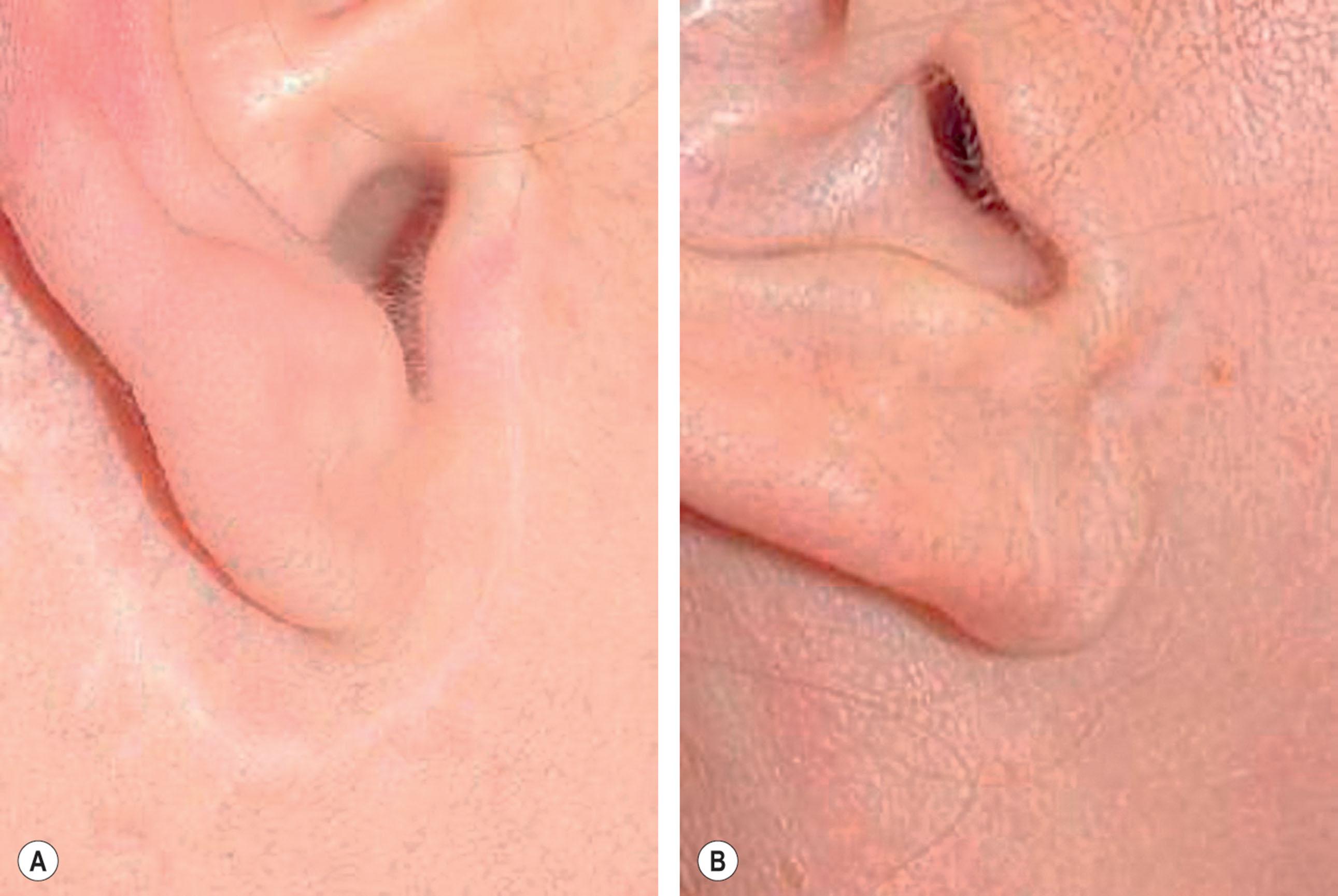
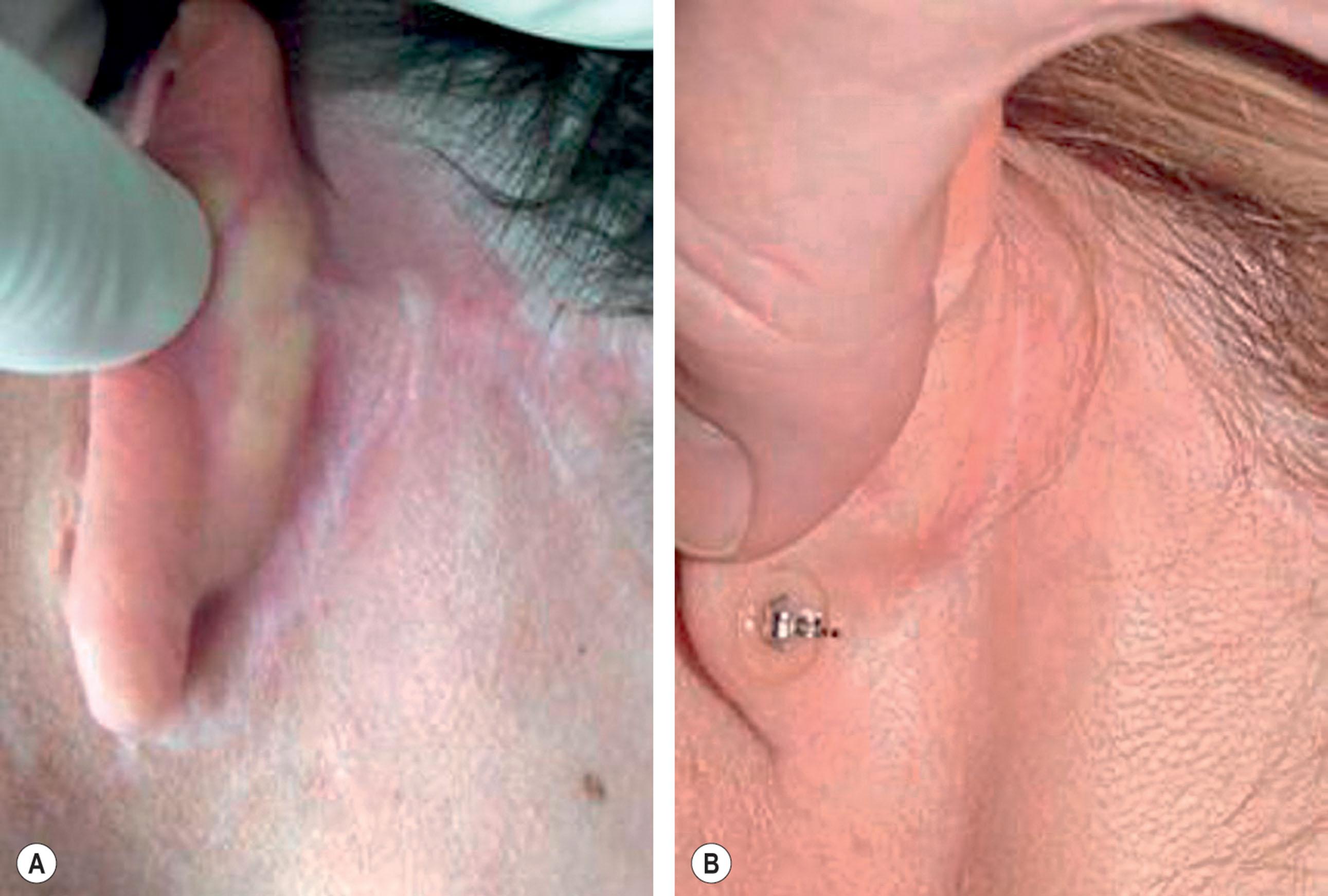
Unlike the pre-helical and postauricular portions of the facelift scar, however, which should be placed directly in their respective anatomic creases, the perilobular scar should not lie directly in the lobular-facial crease if the earlobe is anatomically naturally shaped because the crease itself constitutes a delicate, aesthetically significant anatomical subunit that cannot be easily reconstructed and should not be disrupted when possible. Other factors being equal, a superior result will be obtained if the scar is situated 1–2 mm inferior to this junction and an attempt is not made to join thin, soft earlobe skin directly with course, thick cheek skin.
As is the situation with the relocation of other scars about the ear, relocation of the perilobular portion of the facelift scar at the time of secondary or tertiary facelift will depend on the amount of lower facial skin that remains after the primary procedure. If cheek skin excision has been excessive at the primary procedure, or if a “pixie” earlobe is present, relocation may not be possible. For these patients, it must be accepted that only partial correction can be accomplished.
A poorly located postauricular scar, although not as readily apparent and easier to disguise in most social situations than a poorly situated scar in the preauricular region, is nonetheless an objectionable irregularity that should be corrected when possible. Typically, the poorly located postauricular scar will be seen to lie outside the auriculomastoid sulcus, and too low over the mastoid to be concealed by the pinna. Such an irregularity is the result of poor planning and inferior–posterior migration of the post-auricular flap due to excessive tension placed upon it at the primary procedure ( Figs. 9.12.20A & 9.12.25 ).
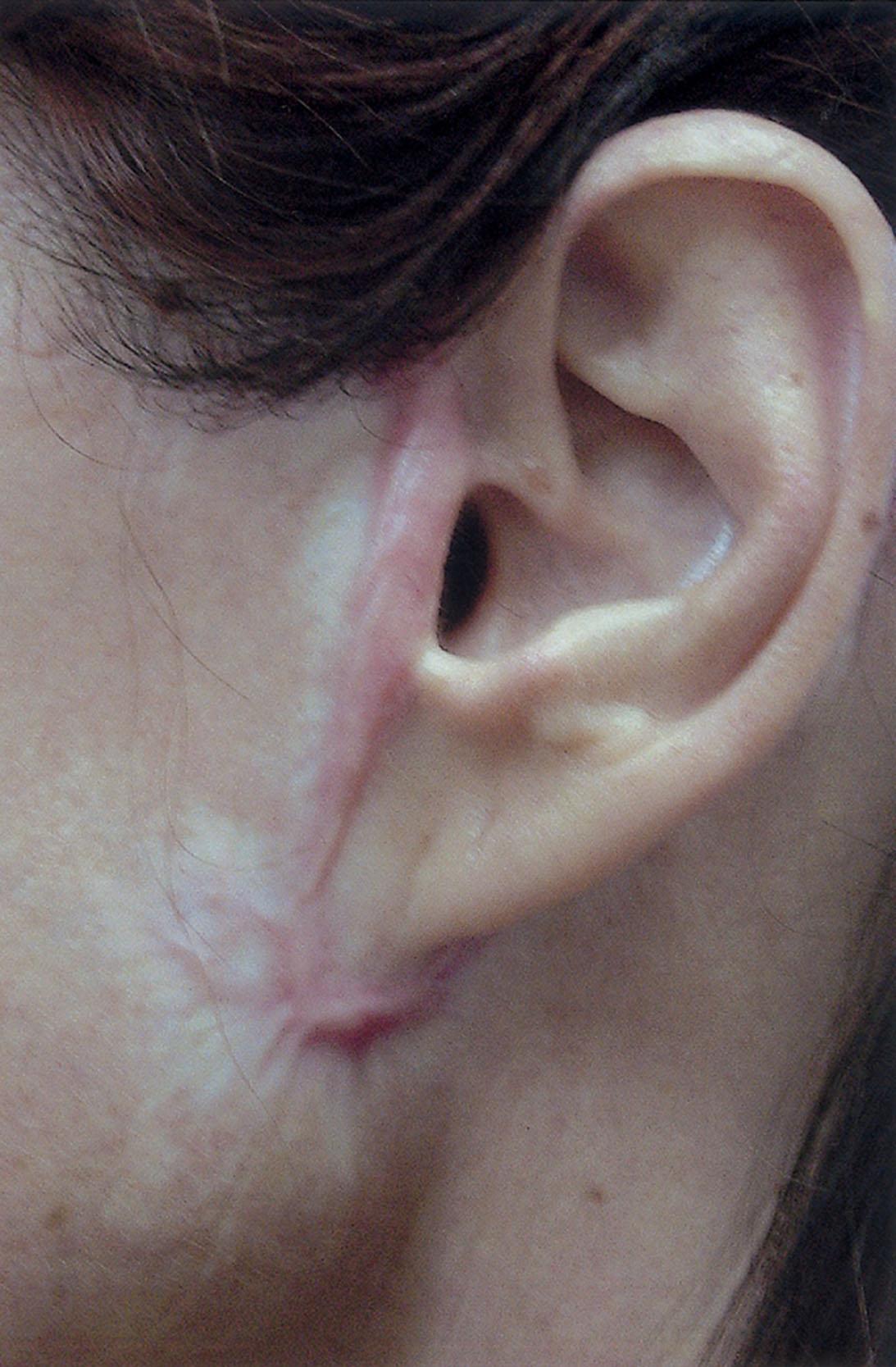
Moving the postauricular scar so that it rests directly in the auriculomastoid sulcus is sometimes possible in secondary and tertiary patients, if tissue sacrifice has not been excessive or along an improper vector at the primary procedure. Moving the scar more superiorly, although seemingly straightforward, is often difficult because of the common practice of inappropriately excising tissue from the superior margin of the postauricular skin flap at the primary procedure. Attempts to do so will often result in a forced closure under excessive tension and eventual inferior migration and widening and hypertrophy of the scar due to inferior traction on the postauricular flap. Although an apparent redundancy will be present in the supine patient on the operating table due to a high-lying position of the shoulders, this will be seen to vanish in the upright position when the shoulders fall to a normal position. As a result, little if any redundant skin is typically available along the needed superior vector of shift.
The submental incision will frequently be seen to have been erroneously placed directly along the submental crease in a well-intended effort to hide the resulting scar ( Fig. 9.12.21A ).
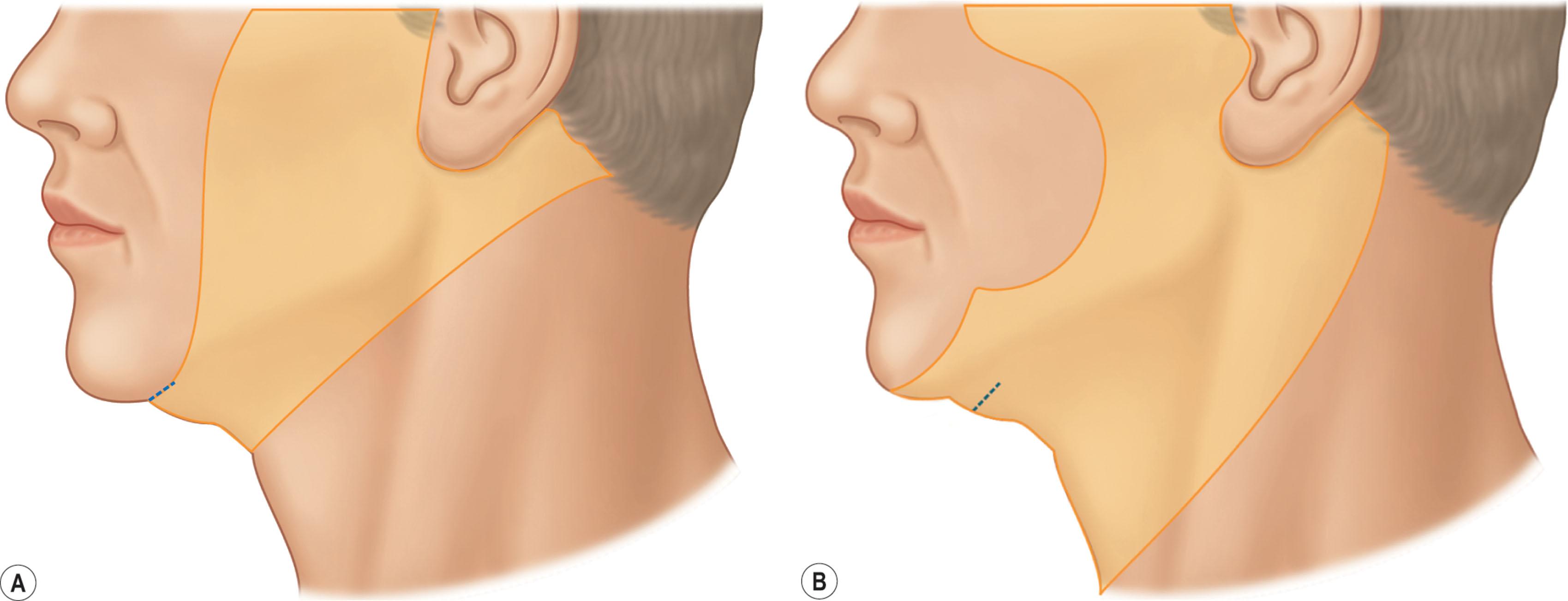
Regrettably, this serves only to reinforce the submental retaining ligaments and accentuate a “double chin” or “witch’s chin” appearance. In such situations, consideration should be given to moving the submental incision 1–2 cm posterior to the crease so that the existing scar can be undermined and released ( Fig. 9.12.21B ). Although this results in a new scar, it will be inconspicuously hidden in the shadow of the mandible in all but the unusual case ( Fig. 9.12.22 ).
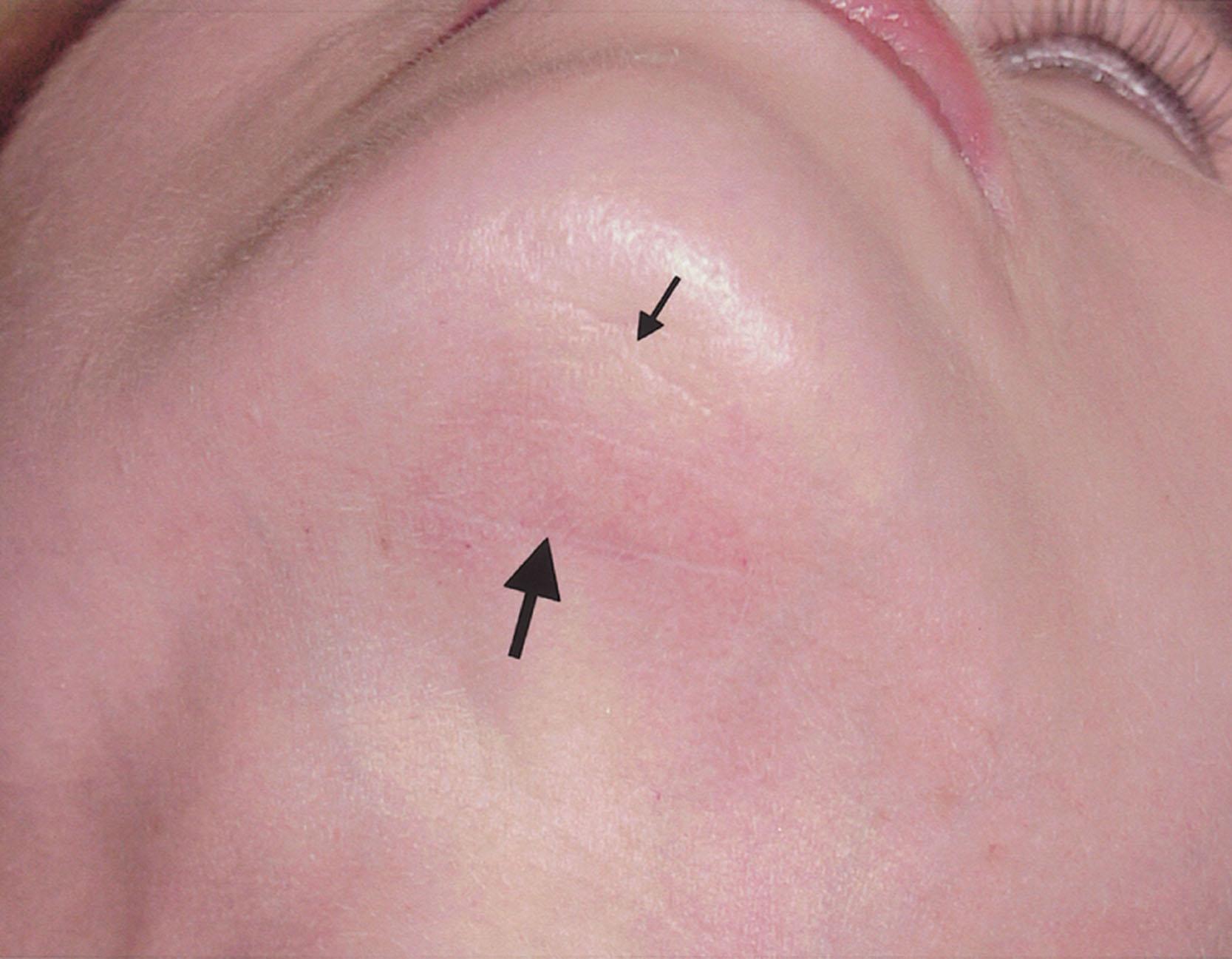
This is preferable and a worthwhile trade-off in many patients for correction of the more obvious and objectionable contour irregularity that would result if the incision were made again in the same place upon the existing scar. If limited work in the neck only is needed and minimal or no double chin irregularity is present, it may be possible and appropriate to use an existing scar in the submental crease as the site for secondary incision. If more extensive maneuvers are required and a marked double chin irregularity is present, however, a new more posteriorly situated submental incision is arguably indicated ( Fig. 9.12.23 ).
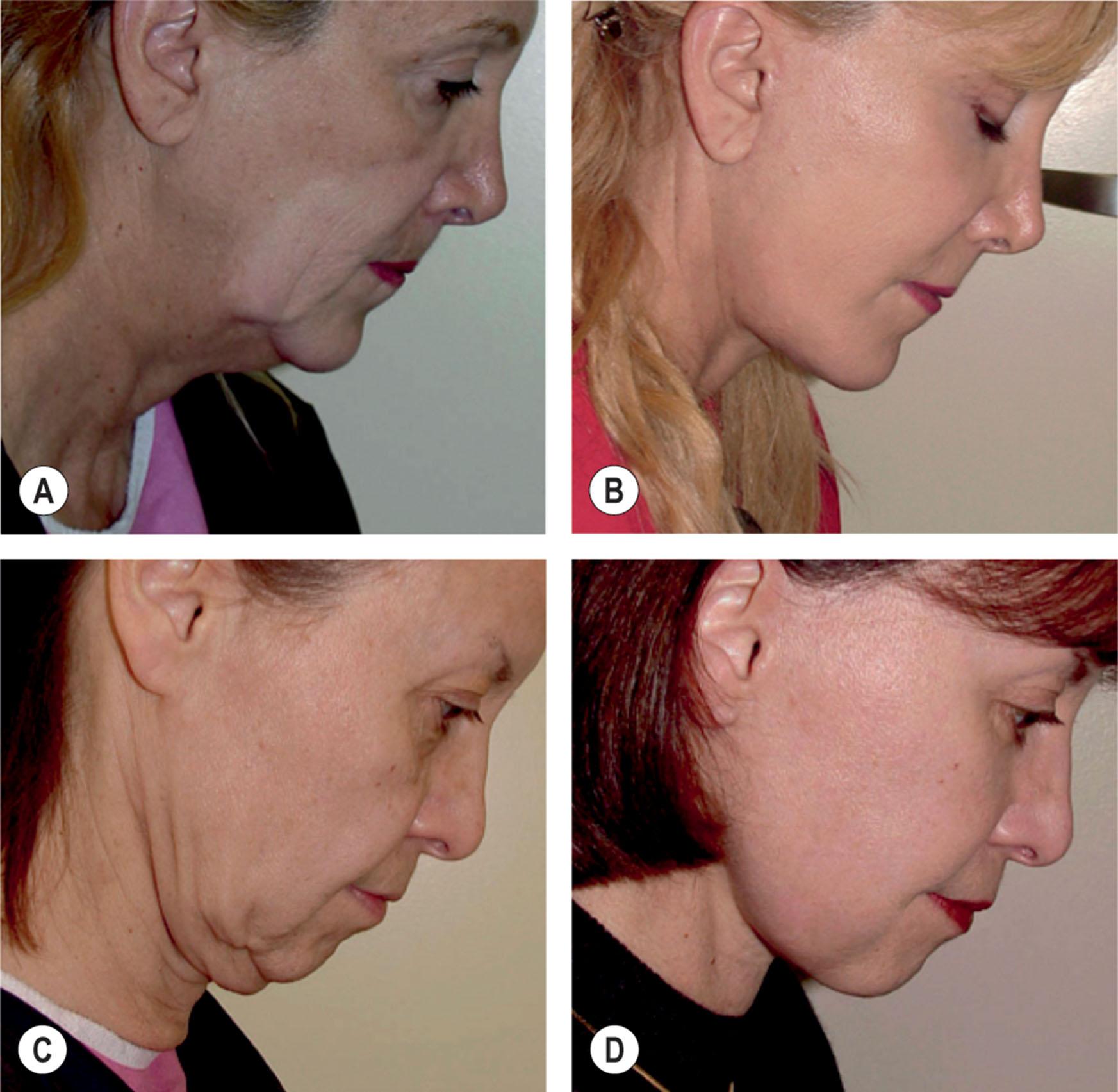
If skin excision has been aggressive and excessive at the primary procedure, relocation of poorly located scars may not be possible at the time of request for secondary facelift, regardless of how much the patient and surgeon would wish otherwise. These patients have typically undergone aggressive skin-only, non-SMAS procedures and have overly tight faces with wide and/or hypertrophic scars ( Fig. 9.12.24 ).
Often earlobes have been pulled or placed too far inferiorly into the cheek as well, compounding the problem. In such cases, it is usually best to defer surgery until scars are mature, skin has relaxed, and adequate tissue is available to make proper repair. In most cases, this will mean waiting until 2–3 cm or more of skin can be pinched up along each jawline along a line extending from the chin to the lobule. Re-operation in the absence of adequate skin to make proper repair will be a frustrating act of futility in which little if any benefit will be gained.
Wide, thick, hypertrophic, and keloid scars, often attributed to be the result of the patient’s own poor healing, are more often due to the over-excision of skin along improper vectors in procedures in which the surgeon has erroneously employed skin tension as a vehicle to lift sagging deeper-layer tissue, rather than the SMAS and platysma. In fact, it is noteworthy that scar widening and hypertrophic healing are rarely seen after a primary facelift in patients of all skin types, provided a SMAS technique that produces no skin tension is used.
Because the factors underlying suboptimal healing leading to wide or hypertrophic scars are still present to some extent in the patient requesting secondary surgery, each must be approached with caution. Like the patient with a skin shortage and poorly located scars, the patient with wide or hypertrophic scars may be impossible to effectively treat if skin excision has been excessive at the primary procedure ( Figs. 9.12.24 & 9.12.25 ). This is true, regardless of how much the patient and surgeon wish otherwise. Re-operation in the absence of adequate skin to make proper repair will be a frustrating act of futility in which little, if any, benefit will be gained.
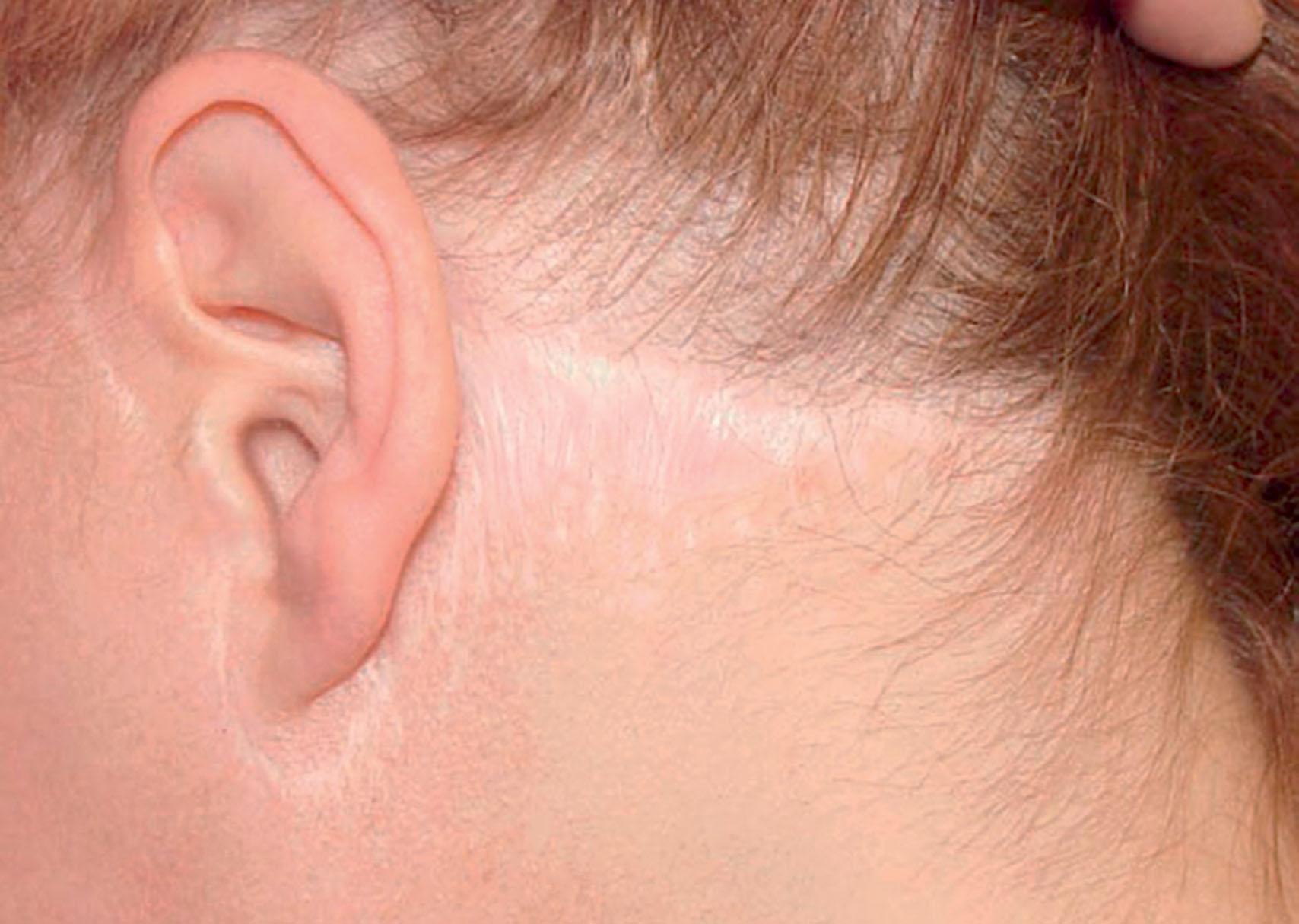
Cross-hatched scars are a completely avoidable irregularity commonly seen in patients presenting for secondary facelift. Like most secondary facelift irregularities, they are the product of errors in both planning and technique. The underlying cause of most cross-hatched scars can be traced directly to skin tension and tension-based facelift techniques. When incisions are closed under tension, larger sutures must be used, and these must be tied tighter and left in longer. Inevitably, varying degrees of necrosis occur beneath each, and these spots go on to heal as scars or hypopigmented areas. As skin relaxation occurs, over time, the hatch marks and suture hole scars stretch and migrate away from the incision scar, giving the appearance that the wound was closed in a crude fashion with large, widely placed sutures. Almost always cross-hatched scars are accompanied by other signs of over-reliance on skin tension, including hairline displacement, hypertrophy, and wide scars ( Fig. 9.12.26 ).
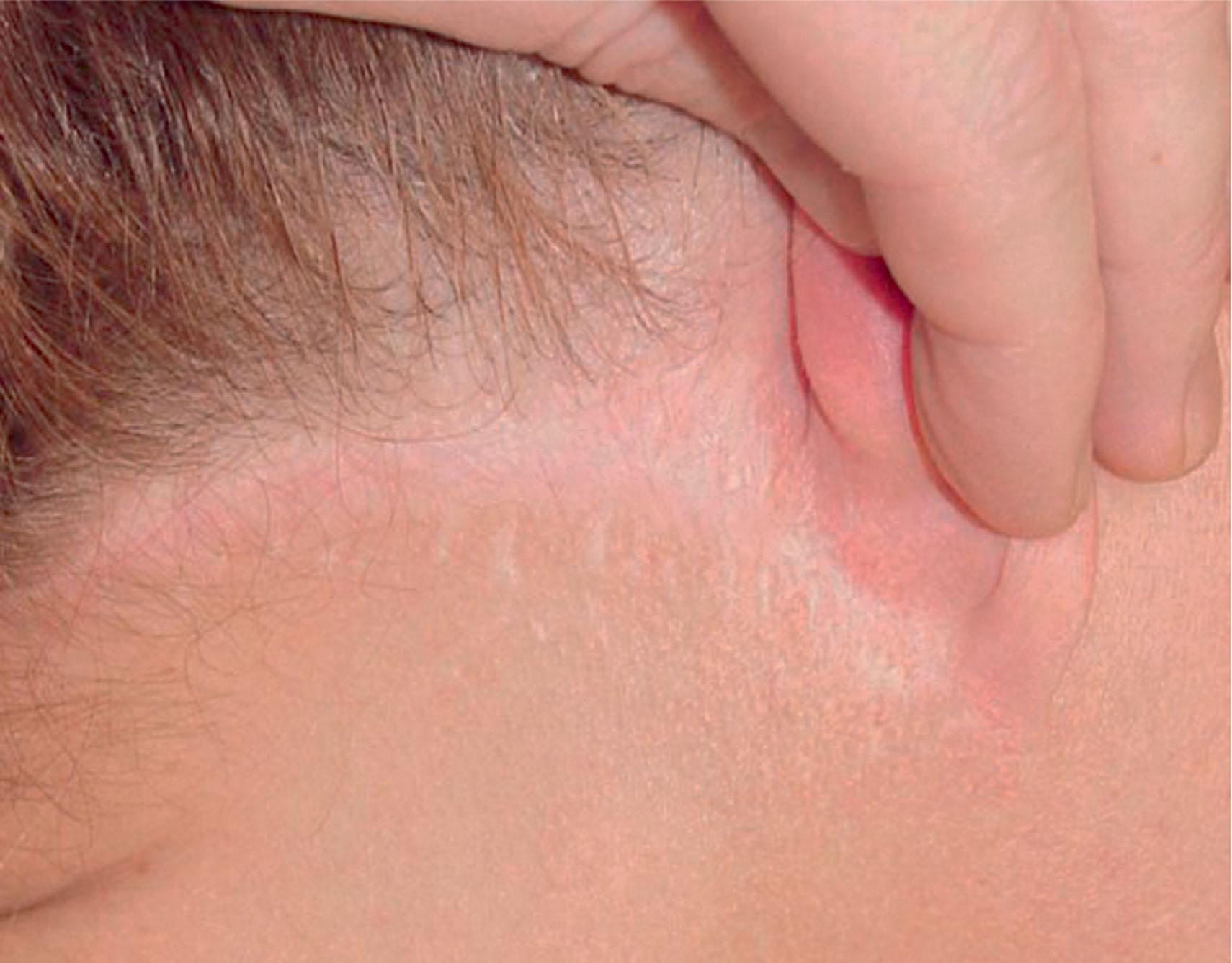
Cross-hatched scars can simply and easily be avoided by employing a facelift technique that does not rely on skin tension. Diverting tension to the SMAS allows skin incisions to be closed under little if any tension with loosely tied, fine sutures that can safely be removed in 4–5 days after surgery.
Diverting tension to the SMAS and platysma will not, in and of itself, prevent cross-hatched scars. If skin is closed under tension, or shifted along an improper vector after SMAS and platysma fixation, the opportunity to avoid tension-based secondary irregularities will be lost and one of the major benefits of the utilization of the SMAS and other deep-layer tissue will be subverted.
Accepting that skin need not be tight is difficult for most surgeons trained in classical facelift technique. For many, it seems not only counterintuitive but also at cross-purposes with traditional goals and objectives. Dismissing this idea, and failing to accept related concepts, however, are major stumbling blocks to achieving high-quality scars and a “non-surgical” and natural postoperative appearance.
The correction of cross-hatched scars is often difficult because the factors leading to the problem are still present to some extent in the patient requesting secondary surgery, and each must be approached with caution. As is the situation in the patient with hairline displacement and wide or poorly located scars, for the patient with cross-hatched scars, it may be impossible to effectively treat the cross-hatched scars if skin excision has been excessive at the primary procedure or if enough residual skin redundancy is not present to allow simultaneous excision of scars, skin flap advancement along an appropriate vector, and closure without tension. In many cases the goal will be to reduce and better conceal, but not eliminate them.
It is a common error to think that scars can simply be excised and the skin needed for closure can be recruited by wide undermining of overly tight adjacent areas. Experience will show that re-operation in the absence of adequate skin to allow excision along a proper vector along with a tension-free closure will result in a recurrence of the problem and other associated tension-based irregularities. In most patients, it is best to accept partial correction of the problem, rather than create new or worse problems by attempting complete elimination. Make-up, tattooing or restyling of hair may be necessary to conceal the residual scars.
Become a Clinical Tree membership for Full access and enjoy Unlimited articles
If you are a member. Log in here